Janice Horton's Blog, page 10
December 27, 2023
North Borneo Heritage Railway
Many people come to Kota Kinabalu in Borneo to experience the world-famous sunsets or to climb Mount Kota Kinabalu.
But not us! We’re here for a historic train ride on a locomotive that has steamed along the rail tracks of The North Borneo Railway since the late 1800’s.
The steam locomotive you travel on is one of the rare few trains in the world that still uses firewood and was originally manufactured in 1896 by the Vulcan Foundry in Newton-le-Willows Lancashire UK.
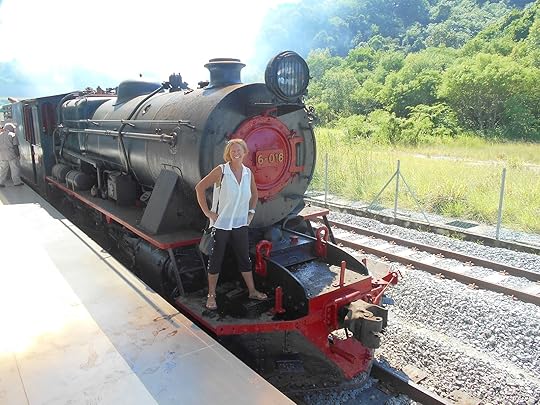 All aboard the North Borneo Express!
All aboard the North Borneo Express!Our trip on The North Borneo Railway would take us through the heart of Borneo, passing through villages and small towns, rubber plantation, rice fields, mangrove swamps, and steamy jungle.
 The North Borneo Railway would take us through the heart of Borneo.
The North Borneo Railway would take us through the heart of Borneo.Along the way, there are also spectacular coastal views of the South China Sea.
All from a vantage point not often experienced today and on a truly nostalgic journey by stream train from Tanjung Aru Station through to the town of Papar.
It’s like stepping back in time through North Borneo history to colonial times.
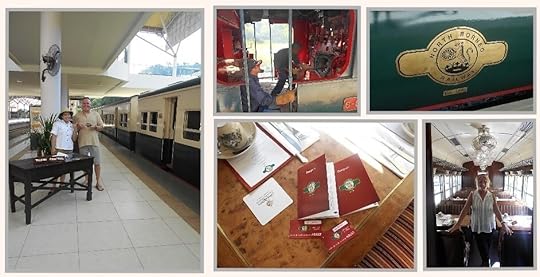

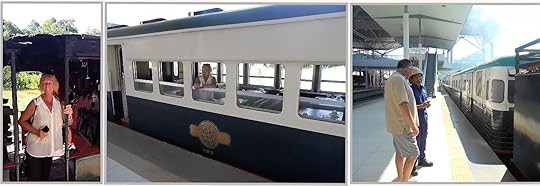 Like stepping back in time through North Borneo history to colonial times
Like stepping back in time through North Borneo history to colonial timesThe North Borneo Railway steam train comprises of 5 coaches, each named after a small town along the 134 kilometres (83 miles) route.
The journey begins at Tanjung Aru Station, passing through Putatan and Kawang, stopping at the historic town of Kinarut to visit the Tien Shi Templea Buddhist temple, before arriving at Papar town.
All aboard the North Borneo Express!We had the most amazing half-day trip travelling on this fabulous old steam train re-living the by-gone era of old colonial times.
I loved that we were greeted at the Tanjung Aru Station by staff wearing old colonial style uniforms of shorts and ‘pith helmets’.
And that we were given travel ‘passports’ as keepsakes to be stamped at every town we travelled through.
Breakfast and lunch are included in the price of the ticket.
We had a delicious served breakfast to us on the outbound journey.
We also enjoyed a wonderfully tasty ‘Tiffin Lunch’ on the way back, served in charming traditional stackable metal containers.
Our lunch menu included items such as Satays, Chicken Briyani, Prawns, Vegetables and fruits.
The atmosphere on the train is so romantic and nostalgic!
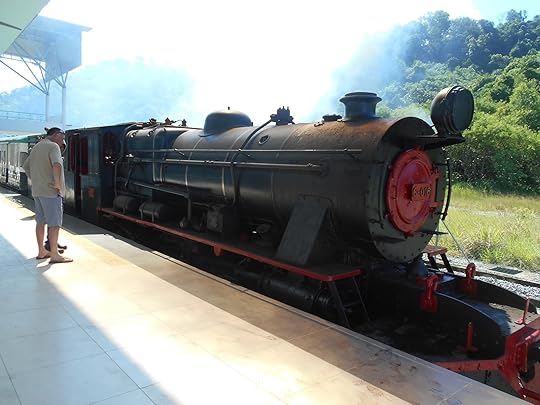
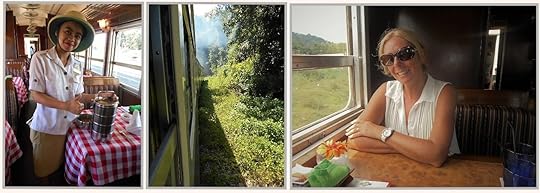
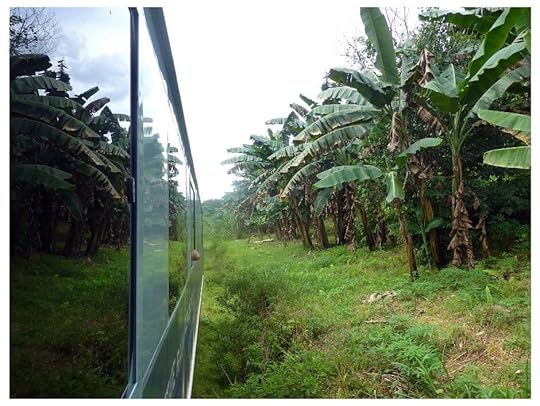 The atmosphere on the train is so romantic and nostalgic!
The atmosphere on the train is so romantic and nostalgic!The air conditioning is simply a warm draught from an open carriage window.
It felt wonderful – once we got up some speed (20mph) – to have a breeze coming into the train along with wafts of wood smoke from the engine.
As chugged along through the small towns, we waved at cheering waving people.
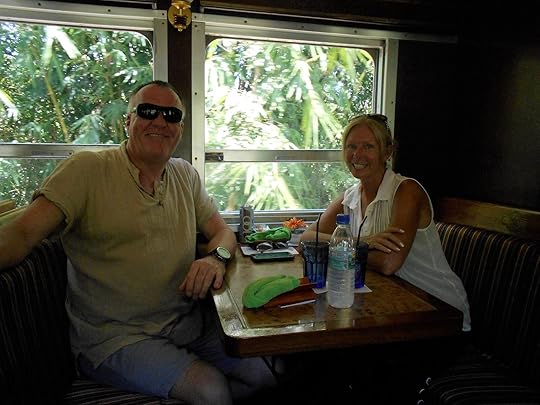 Our trip on The North Borneo Railway would take us through the heart of Borneo
Our trip on The North Borneo Railway would take us through the heart of BorneoThe half-day (four hour) schedule operates every Wednesday and Saturday.
The train departs Tanjung Aru Railway station at 10am to Papar and returns to Tanjung Aru Railway Station at approximately 1.45pm.
You can find out more about the historic North Borneo Railway and the current North Borneo railway schedule, ticket price, and booking information via Sutera Harbour Resort who operates the tours.
North Borneo Railway Contact Details: Tel : +60 88 308 500 Email: nbrinfo@suteraharbour.com.my
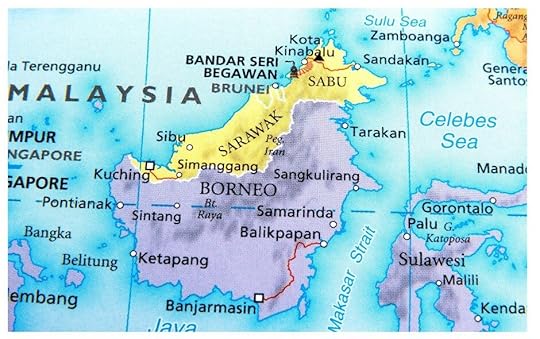 Borneo Map: I marked the train route from Kota Kinabalu to PaparMalaysian Borneo
Borneo Map: I marked the train route from Kota Kinabalu to PaparMalaysian BorneoThere are two distinct sides to Malaysia. West (Peninsular) Malaysia and East (Borneo) Malaysia and they are separated by the South China Sea.
Trav and have explored most of the Malaysian peninsular including the capital city of Kuala Lumpur and the islands of Penang and Langkawi on the west side and also the Perhentian Islands on the east side.
But up until now we haven’t ever ventured across to Malaysian Borneo.
 There are two distinct sides to Malaysia. West (Peninsular) Malaysia and East (Borneo) Malaysia
There are two distinct sides to Malaysia. West (Peninsular) Malaysia and East (Borneo) MalaysiaWe flew from Kuala Lumpur to the town of Kota Kinabalu.
Kota Kinabalu or KK is known is the capital of Sabah – the northern part of Borneo – and is the gateway to the Kinabalu National Park.
After our amazing North Borneo train trip we headed back into KK town to enjoy the waterfront bars and restaurants and to experience the evening backdrop of a world famous Kota Kinabalu sunset.

The sunsets seen from KK are legendary for their spectacular red, orange, and magenta hues and we were not disappointed.
The sunset was simply breathtaking!
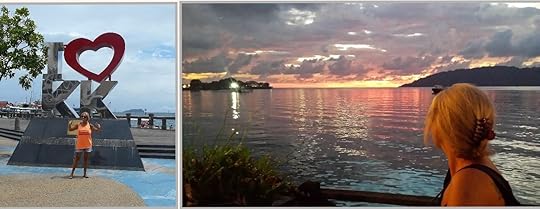
We stayed overnight in a small guesthouse in Kota Kinabalu that we’d booked using (affiliate link) Booking.com.
The Api-Api Guesthouse was in a great location for the waterfront area and only 2km from the North Borneo Railway.
But, the following day, keen to enjoy one of Kota Kinabalu’s fabulous beach resorts, we spotted an out-of-season offer on (affiliate link) Booking.com and moved up the coast a little to stay for a few nights at Nexus Resort and Spa Karambunai.
It was a great idea to mix up a night of basic accommodation with a couple of nights of bargain luxury!
 KOTA KINABALU TO SANDAKAN
KOTA KINABALU TO SANDAKANAfter a few days at the beach, we were keen to be back on a plane and to fly a considerable distance across the country to Sandakan in the Eastern Sabah region of Borneo.
The reason for this trip was to see Orangutans in the wild at the Sepilok Orangutan Rehabilitation Centre – the precious home of the last wild Orangutans of North Borneo – and I was SO excited!
Meeting Orangutans in the wild in Borneo is the subject of my next travel post – so do pop back soon!
You can also read more about these experiences in Borneo in My 10 Greatest Travel Experiences.
Do you love a train journey?
Would you like to ride on the North Borneo Railway?
Leave a comment below or contact me directly.
Any questions? I’ll be delighted to hear from you!

The post North Borneo Heritage Railway appeared first on The Backpacking Housewife.
December 26, 2023
Hong Kong: Travel Guide
Exciting and exotic Hong Kong with its rich history and fascinating culture and unique status as a place where east meets west has long been a fascination.
For a few days in September, the backpacking husband and I were in Macau – the Las Vegas of Asia.
From Macau, we took the one-hour high-speed ferry over to Hong Kong.
Although, we were visiting in the wake of a typhoon that had hit both Macau and Hong Kong (September is still officially in the typhoon season) and the weather was sometimes cloudy and a little wet, as you’ll see in my photos.
But that didn’t stop us from having the most fabulous time exploring Hong Kong!
 The weather was sometimes cloudy and a little wet!EXPLORING HONG KONG
The weather was sometimes cloudy and a little wet!EXPLORING HONG KONGWe stayed for five nights in Hong Kong in a great location close to Times Square at The Holiday Inn Express on Causeway Bay.
We found and booked our Holiday Inn Hotel using (affiliate link) Booking Dotcom.
The first thing we did after checking in was to put on comfortable shoes for a sightseeing walk.
We love walking and believe it’s the very best way to see the sights and attractions of any city but especially Hong Kong.
This is my list of Top 10 Things To Do In Hong Kong!
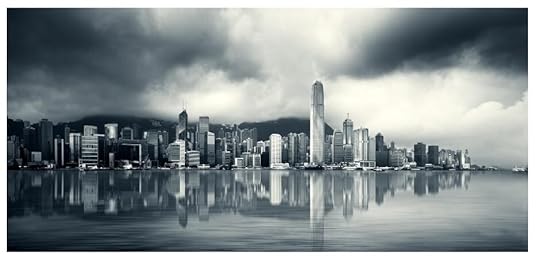 MY TOP 10 THINGS TO DO IN HONG KONG
WALKING
MY TOP 10 THINGS TO DO IN HONG KONG
WALKING
Getting around on foot allowed us and to browse the shops and markets and street food stalls of Hong Kong. We walked the 3km (just under 2 miles) from Causeway to Victoria Harbour but if you don’t want to walk that far – especially if you are visiting in the summer when it is hot and very humid – there are plenty of easy transport options available to you.
The transport system around the city is really good with a constant stream of buses and trams and trains and subway trains and taxis and boats to take you quickly and easily to wherever you want to go.
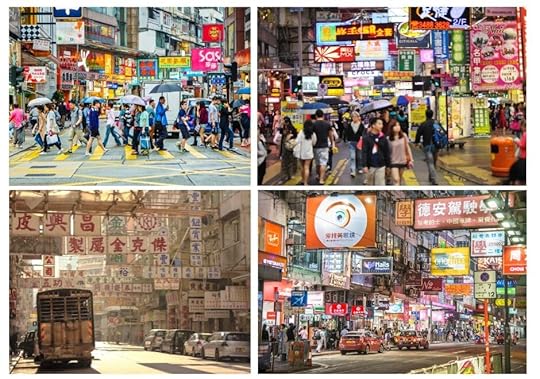 Walking is the very best way to see the sights and attractions of Hong Kong.
RIDE A DING DING
Walking is the very best way to see the sights and attractions of Hong Kong.
RIDE A DING DING
We loved riding the Ding Ding! In Hong Kong, the term “ding ding” typically refers to the distinctive retro look green and white double-decker trams that are an iconic mode of public transportation in the city.
These trams have been operating in Hong Kong since the early 20th century and the nickname is derived from the sound of the bell used to signal their approach or departure.
We often hopped onto a Ding Ding when heading back to our hotel.
Great fun and a worthy experience on my list of Top 10 Things To Do In Hong Kong!
 In Hong Kong ride the Ding Ding!
EAT DIM SUM
In Hong Kong ride the Ding Ding!
EAT DIM SUM
Feeling hungry, we found a restaurant called Dim Sum Square. We actually went twice as they had the best dim sum we’d ever tasted.
As you might expect, the best dim sum is in Hong Kong!
We also drank Yum Cha Chinese tea in a tea house and ate at several other small restaurants – not the fancy western ones or hotel linked ones – but the Cha Chaan Teng in the side streets where locals eat and where we found the food delicious, authentic, and reasonably priced.
 As you might expect, the best dim sum is in Hong Kong!
As you might expect, the best dim sum is in Hong Kong!I’m normally quite adventurous with food and I was excited to see a fabulous meld of Cantonese and Hong Kong foods on offer.
I was also fascinated to see the various bugs and insects and sea creatures and unusual parts of animals that were being cooked and eaten in Hong Kong.

But I have to admit that I couldn’t bring myself to try them.
I stuck to dim sum, clay pot rice, shrimp, chicken, roast duck and goose, etc, instead!
Another aspect of Hong Kong that fascinated and appalled me in equal measures, were the traditional Chinese medicine shops, selling very strange things as tonics and remedies.
I have photos but won’t go into the details.
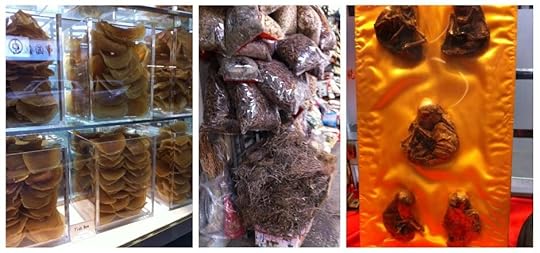 THE STAR FERRY
THE STAR FERRY
The next exciting and iconic thing in my list of Top 10 Things To Do In Hong Kong is to take the famous and charming Star Ferry boat across Victoria Harbour to Kowloon.
It’s a fabulous way to experience a beloved and iconic ferry that has been in operation since 1888 and the most inexpensive way to see the famous Hong Kong cityscape.
 Taking The Star Ferry boat across Victoria Harbour to Kowloon.
GO TO KOWLOON
Taking The Star Ferry boat across Victoria Harbour to Kowloon.
GO TO KOWLOON
We spent some time on Kowloon Island, once again exploring extensively on foot, until we eventually ended up at the famous Temple Street Market.
 GO TO A TRADITIONAL MARKET
GO TO A TRADITIONAL MARKET
The traditional markets of Hong Kong are fabulous cultural experiences.
The most famous are The Ladies’ Market (Tung Choi Street Market) in the bustling district of Mong Kok. Known for its lively atmosphere, this market offers a wide array of goods, including clothing, accessories, toys, and souvenirs.
Then there is Stanley Market, located in the picturesque Stanley area.
The market offers a mix of stalls selling clothing, accessories, artwork, and souvenirs.
Operating primarily in the evening, Temple Street Night Market is the last remaining example of a traditional market in Hong Kong. It is famous for its lively atmosphere and street food and traditional Chinese crafts.
Temple Market is also the star of many a movie.
It’s every moviemaker’s ideal China Town!
We took the Star Ferry over to Kowloon to explore the Temple Street Night Market.
Returning after dark, we used the MRT for a short convenient train journey of just 3 minutes back to Hong Kong Station.
 The colours of Hong Kong at night
VICTORIA PEAK
The colours of Hong Kong at night
VICTORIA PEAK
Another of my very favourite things to do in Top 10 Things To Do In Hong Kong was to visit The Peak using The Peak Tram.
Not only will the tram take you to the top of Victoria Peak – to the Sky Terrace and a 360 degree fabulous view over the whole of Hong Kong and its skyscrapers, the harbour, and all the surrounding islands – but you get there on the world steepest funicular railway.
It was an amazing experience.
And the views – oh my goodness – they are truly breath-taking!

 SAIL A JUNK IN THE HARBOUR
SAIL A JUNK IN THE HARBOUR
On our last night in Hong Kong, we did something so memorable and so iconic and so amazing, that I will forever hold the experience dear to my heart.
We boarded an old junk boat – an old traditional sailing boat with billowing red sails – to cruise out into Victoria Harbour after dark to watch the spectacular Hong Kong lightshow from the best vantage point possible.
The lightshow was incredible and the cruise experience so romantic!
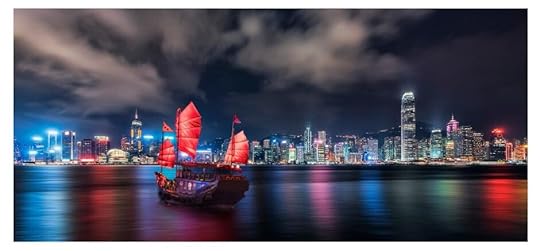
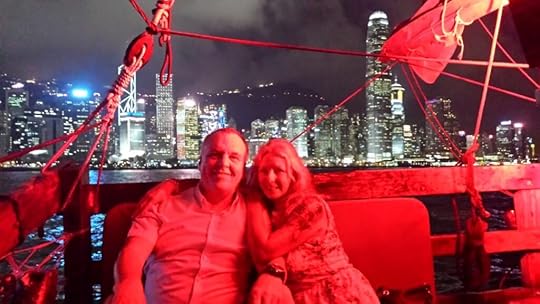 From Victoria Harbour – the lightshow was incredible and the cruise so romantic!
THE SYMPHONY OF LIGHTS
From Victoria Harbour – the lightshow was incredible and the cruise so romantic!
THE SYMPHONY OF LIGHTS
The Symphony of Lights is a spectacular light show set to music and colourful lasers and spotlights and LED screens flashing and streaking across all the tall shiny glass and steel buildings around both sides of the harbour.
The Symphony of Lights is now recognised as a signature icon for Hong Kong.
It happens every night at 8pm and is simply stunning!
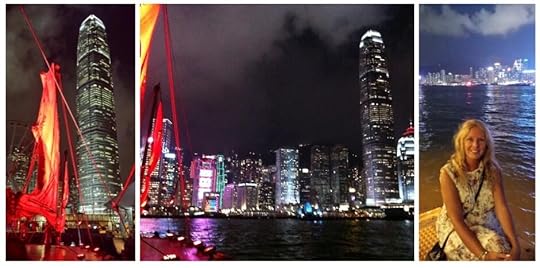 INTERESTING ASPECTS OF HONG KONG
INTERESTING ASPECTS OF HONG KONGSpecial Administrative Region: Hong Kong has a unique status as a Special Administrative Region (SAR) of the People’s Republic of China and is located on the southern coast of China.
History: Hong Kong was a British colony from 1842 until 1997.
Handover to China: On July 1, 1997, sovereignty over Hong Kong was transferred back to China under the principle of “one country, two systems.”
This arrangement was meant to guarantee Hong Kong a high degree of autonomy for its capitalist economic system and its legal system separate from that of mainland China.
Key sectors include finance, trade, logistics, and professional services.
The Hong Kong Stock Exchange is one of the largest in the world.
The Special Arrangement was intended to remain in place until 2047.
In recent years, there have been concerns about the erosion of Hong Kong’s autonomy and freedoms, leading to protests and tensions between pro-democracy activists and the Chinese government.
It’s important to note that the situation in Hong Kong is dynamic and I recommend you check latest sources for the most up-to-date information.
The currency of Hong Kong is the Hong Kong Dollar abbreviated as HKD or HK$.
 Hong Kong as viewed from The Peak
HOW MANY DAYS TO SPEND IN HONG KONG?
Hong Kong as viewed from The Peak
HOW MANY DAYS TO SPEND IN HONG KONG?
If you visit Hong Kong for just a few days (four days/5 nights) as we did, I hope you’ll find my guide useful to you. There is, however, so much more to do in Hong Kong that a longer stay could easily be warranted.
I hope to one day return to take in the temples and theme parks and museums and the shows and to visit the Sky100 Hong Kong Observation Deck on the 100th floor of the tallest building in Hong Kong.
THE BEST TIME TO VISIT HONG KONGHong Kong is a bustling city that attracts visitors year-round. It’s a good idea to check for any major festivals or events that may influence your travel plans, and do always monitor weather forecasts, especially during typhoon season.
We visited at the end of summer – in early September – in the wake of a powerful typhoon!
Spring (March to April): Spring is a great time to visit as temperatures are mild, ranging from 18°C to 26°C (64°F to 79°F). It’s not too hot or humid, and the city is often covered in beautiful blooms.
Autumn (October to early December): Similar to spring, autumn/fall offers mild temperatures and lower humidity, making it an ideal time to explore the city. Temperatures range from 19°C to 28°C (66°F to 82°F).
Winter (December to February): Hong Kong experiences a mild winter with temperatures ranging from 12°C to 20°C (54°F to 68°F). While it’s not extremely cold, it can be cool, and there may be occasional fog.
Summer (May to September): Summer is hot and humid in Hong Kong, with temperatures ranging from 26°C to 31°C (79°F to 88°F). It’s also the typhoon season, with the highest chance of tropical storms and heavy rainfall.
MY TOP 10 THINGS TO DO IN HONG KONGAfter enjoying the experiences of 1 through 9 – my #10 of my Top 10 Things to Do In Hong Kong is:
GO TO MACAUHong Kong is part of the Greater Bay Area, along with Macao and nine municipalities in southern China’s Guangdong Province.
So, as an exciting addition to a trip to Hong Kong, I would also highly recommend visiting neighbouring Macau, for just a couple of fun nights.
As I mentioned, it’s just an hour away from Hong Kong by high-speed ferry, and it is quite surreal in its similarity to Las Vegas USA with its themed hotels and resorts and casinos and fabulous shows and dining options.
You might like to find out more in my post on Macau – The Las Vegas of Asia.
I will forever hold our visit to Hong Kong in my heart.
It is a wonderful, romantic, exciting, and memorable city.
Have you been to Hong Kong?
Is it on your bucket list?
Let me know? I’d be delighted to hear from you!
Contact me or leave a comment below.

The post Hong Kong: Travel Guide appeared first on The Backpacking Housewife.
December 24, 2023
Macau – The Las Vegas of Asia
Macau – the Las Vegas of Asia – it’s long been on my bucket list.
While travelling in Asia, I was keen to experience the fun attractions and the cosmopolitan hotels and Macau casinos and resorts and see how they compared to their doppelgangers in Las Vegas, USA.
In September, we flew to Macau from Kuala Lumpur, Malaysia. But, right up to the day of our departure, we really didn’t know if our trip was actually going ahead because just a few days earlier, a devastating typhoon had hit Macau.
We certainly didn’t want to add to the burden of the recovery effort, so decided to contact (affiliate link) The Holiday Inn MacauBooking.com UK Homepage ">, where we were staying to check on the status of our booking.
">, where we were staying to check on the status of our booking.
But it was made clear to us that the city was recovering quickly and it was business as usual.
Same from The Parisian Hotel, where we had tickets for the final night of the Michael Jackson tribute show, ‘Thriller’.
Just to be sure, I contacted our airline for an update and was told that our flight was as unaffected and as scheduled.
So we decided to go ahead with our trip to Macau but we’d confine our stay to the Cotai Area and The Strip.
This meant we’d keep away from the historic part of Macau, as news reports were saying it had been hit worst by the typhoon.
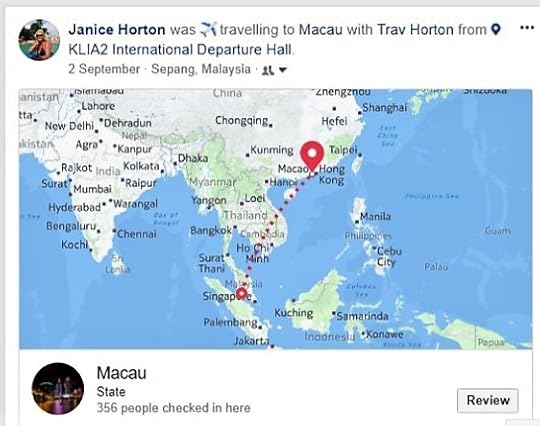 My Facebook travel update!
My Facebook travel update!On arrival, the weather in Macau was not so good – it was wet and stormy – but that hardly mattered when almost all the hotels and attractions in Macau are undercover. On the occasion that we did briefly venture outside, we did see evidence of storm damage. Many high-rise hotels had broken windows and at ground level many palm trees looked like broken stumps.
We did manage a fun ride in the gondolas at The Wynn and we had a fabulous lunch at The Wynn too – at the famous Fontana Buffet – which we had also enjoyed in Vegas. I can report that in comparison they are both equally as good!
 We had a fabulous lunch at The Wynn Macau
We had a fabulous lunch at The Wynn Macau The famous Wynn and Fontana Buffet Macau
The famous Wynn and Fontana Buffet Macau We had a walk around all the famous the resort hotels that both Macau and Las Vegas are known for: The Wynn, The Venetian, The Mandarin Oriental, The Ritz Carlton, The St Regis, The Conrad, The Sheraton, and others.
Still in Macau – but not Las Vegas – is the famous Sands Hotel and Resort.
 The famous Sands Hotel and Resort Macau
The famous Sands Hotel and Resort Macau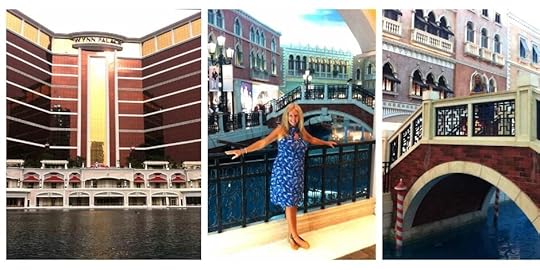 The Wynn Hotel and The Venetian Macau
The Wynn Hotel and The Venetian Macau The contemporary MGM Resort Macau
The contemporary MGM Resort Macau At the gondola ride at The Venetian Hotel Macau
At the gondola ride at The Venetian Hotel MacauInside The Venetian, I wouldn’t have known that I wasn’t in the one in Vegas. It’s exactly the same.
With its canals and operatic singing gondola drivers and exclusive shops and fabulous sky dome interior.
But the highlight of our trip to Macau was attending The Thriller Live Show at the Parisian Hotel.
A show that had started in the West End in London and travelled throughout the world.
It was the final night of the show in Macau. It was truly fabulous and everyone was up dancing!
 Thriller Live Show at the Parisian HotelINTERESTING ASPECTS OF MACAU
Thriller Live Show at the Parisian HotelINTERESTING ASPECTS OF MACAUSAR: Macau, located on the southern coast of China, is officially known as the Macao Special Administrative Region of the People’s Republic of China. (SAR) Macau operates under the “one country, two systems” principle similar to Hong Kong.
History: Macau was the first and last European colony in China. It has a rich history, having been a Portuguese colony for over 400 years, until it was handed back to China in 1999.
Economy: Macau’s economy is heavily dependent on tourism and gaming. It is often referred to as the “Las Vegas of Asia” due to its thriving casino industry and it being a major destination for gamblers from around the world.
Although much smaller in size than Las Vegas, Macau has actually surpassed Las Vegas in terms of gambling revenue!
The Macanese Pataca (MOP) is the official currency of Macau.
Food: Macau is renowned for its unique culinary scene, which is a fusion of Chinese and Portuguese influences. The city is famous for its street food, dim sum, and Portuguese egg tarts.
 The Strip Macau CityscapeMACAU TO HONG KONG
The Strip Macau CityscapeMACAU TO HONG KONGAfter a truly amazing couple of days in Macau, the backpacking husband and I were excited to also be heading to Hong Kong.
Hong Kong is only an hour away from Macau by High Speed Ferry.
 Hong Kong is only an hour away from Macau by TurboJet High Speed Ferry
Hong Kong is only an hour away from Macau by TurboJet High Speed FerryDo join me travelling to Hong Kong in my next post in which we eat dim sum in Dim Sum Square, ride along the streets on a ‘ding-ding’, explore the colourful harbour and admire the famous skyline, take a tram up to Victoria Peak and a Star Ferry over to the island of Kowloon with its famed Temple Street Market!
Have you ever experienced Macau?
Is it a place you’d find interesting?
Leave a comment and let me know?
In Macau, we stayed at The Holiday Inn Macao and we booked with Booking Dotcom.
In case of unplanned flight or hotel cancellations I recommend travel insurance.
Get a no-obligation quote from World Nomads today.

The post Macau – The Las Vegas of Asia appeared first on The Backpacking Housewife.
December 23, 2023
Housesitting – Live Like a Local!
Are you an active and ardent housesitter who loves to live like a local by housesitting in other places and other people’s homes?
Or, are you a homeowner who wouldn’t dream of putting the family pets into expensive kennels while you’re on holiday, because you know you can get a responsible housesitter in to care for your home and your pets for free?
Perhaps you’re curious about how a housesit works and how to live like a local by housesitting?
As an active and ardent housesitter myself – I’m housesitting with my backpacking husband right now in Southwest France – I want to show you how we slow down by housesitting between our nomadic world travels.
How we use the housesitting experience to ground ourselves and achieve some downtime in a life that would otherwise be constant movement and travel.
How we ‘live like a local’ by housesitting in other places and other countries.
 Our fabulous long-term housesit in France
Our fabulous long-term housesit in FranceWe’ve done most of our housesitting in France. Except for one time when for two weeks, we looked after a beautiful beach house and two very sweet dogs in the Caribbean, while the owners were away on holiday in Europe.
 A two week long housesitting and looking after two sweet doggies in the Caribbean.HOW DID WE DISCOVER HOUSESITTING?
A two week long housesitting and looking after two sweet doggies in the Caribbean.HOW DID WE DISCOVER HOUSESITTING?I have tried to cover everything in this post that we have experienced while housesitting, but if you have any questions, do leave a comment at the end of the post or contact me directly. I’ll do my best to answer your questions.

Three years into our nomadic travelling lifestyle, after we’d sold everything to travel the world full-time, I signed a contract with HarperCollins Publishers.
I had a contract to write a series of three romantic adventure novels loosely based on my own travel experiences and adventures.
You can find out more about my writing on my Books Page.
 Click the image to see my books on Amazon
Click the image to see my books on AmazonI had actually started writing the first book while we were travelling in Asia and immediately fell into difficulties.
Firstly, I didn’t have a desk, so I had to write while sitting on the bed in our homestay.
Secondly, I had set up a writing schedule spreadsheet to make sure I could achieve my wordcount and my tight contractual writing deadlines.
So, I was basically writing in our small room for at least six hours a day.
My husband was becoming bored and had to go sightseeing without me.
We both realised this wasn’t ideal and our nomadic lifestyle wasn’t helping.
We knew if I was to complete the books, then we needed to stop travelling for a while, so I could focus on my writing and he could have something constructive to do with his time.
But how? When we had no routine or a home to call our own?
And then, the backpacking husband, suddenly came up with the great idea of living like a local by housesitting!
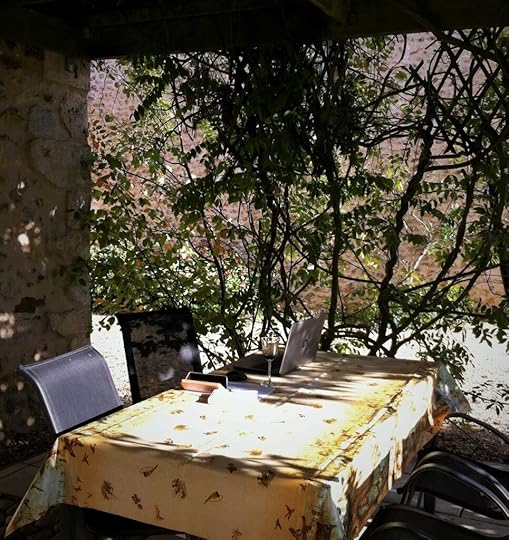 A perfect writing spot in France!WHAT IS HOUSESITTING?
A perfect writing spot in France!WHAT IS HOUSESITTING?Housesitting is a mutually beneficial arrangement between a homeowner and a housesitter which, in my experience, does not involve any money changing hands.
The homeowner can go on holiday or take a longer trip and leave their home and their pets in the capable hands of a responsible housesitter at no charge.
The housesitter/s gets to stay in the house for the agreed period of time, and live like a local by housesitting for free, in exchange for the care of pets and the continued upkeep of the property in the owner’s absence.
A slightly different scenario that we found ourselves in during our very first housesit, was that the UK homeowners didn’t live in the property full time. It was their summer holiday home in South West France.
The property was a chateau – a large family holiday home with extensive grounds – including a swimming pool and two ‘gites’ (cottages on the property) that were rented out to long term French tenants.

Our housesitting responsibilities were to care for one dear old chat – Monsieur Smudge – and live in the chateau over a six-month period during the autumn and winter months.
Housesitting was a perfect job for my handy-man husband and provided a perfect place for me to write as I now had access to a proper study and a desk.
 Writer at work!HOUSESITTING DUTIES
Writer at work!HOUSESITTING DUTIESHousesitting duties included maintaining the garden, cleaning and maintaining the outdoor swimming pool, and other general maintenance as needed, while also attending to any issues that might arise with the tenants renting the gites.
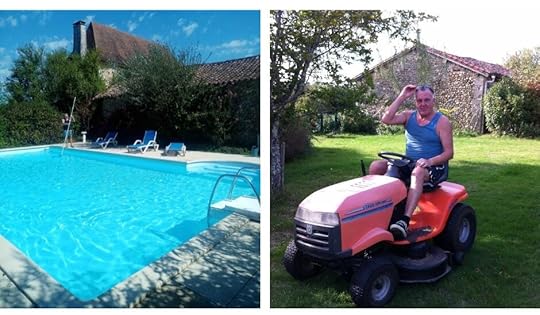 Housesitting duties included managing the property and the grounds
Housesitting duties included managing the property and the groundsWe’d arrived in France from Vietnam in early September and the homeowners stayed on with us for a couple of days while we settled in.
They introduced us to the tenants renting the two gites and showed us what needed doing at the property to keep it maintained while they were away.
The lovely homeowners showed us where we could go shopping and they drove us around the local vineyards and local areas of interest.
We even had use of their car while they were away.
Take a look at my post My Top 5 Wine Tasting Chateau in France – with a guide and map!
 At the local vineyard
At the local vineyardIt was a fantastic housesit for us and peace of mind for them.
September and October in southwest France is still very sunny and warm and we were able to swim in the pool and enjoy eating our meals outside on the terrace.
We discovered local food delicacies and we ate lots of cheese and enjoyed local wine and we made friends with our lovely neighbours in the gites.
In the warmth of that wonderful late summer French sunshine, I often spent the mornings sitting outside in the shade of the fragrant terrace writing, and then stopping for a spot of lunch with my dear husband, whom I could tell was enjoying himself immensely going around on the drive-on tractor mower.
I can tell you that the grounds always looked pristine!
Since that very first housesit – where I finished writing my series of Backpacking Housewife Books – we’ve been fortunate to have returned to the same property many times.
We’ve enjoyed all four seasons and a wonderfully immersive French lifestyle in this house. In fact, if we were to add up all the months we’ve looked after this beautiful home – on and off over the past ten years – we’ll have lived here for two years and this will be our second Christmas here!
 We’ve enjoyed all four seasons and a wonderfully immersive French lifestylePETSITTING
We’ve enjoyed all four seasons and a wonderfully immersive French lifestylePETSITTINGWe’ve also done a different kind of housesitting assignment in France.
A few years ago, through the winter months of October through to March, and while the homeowners were travelling Asia, Australia and New Zealand, we housesat at an old ‘bastille’ (a fortified farmhouse) in the Mid-Pyrenees of South of France.
That time, we had a horse, two donkeys, a herd of sheep, a sheepdog, lots of poultry and several cats to care for while the owners were away.
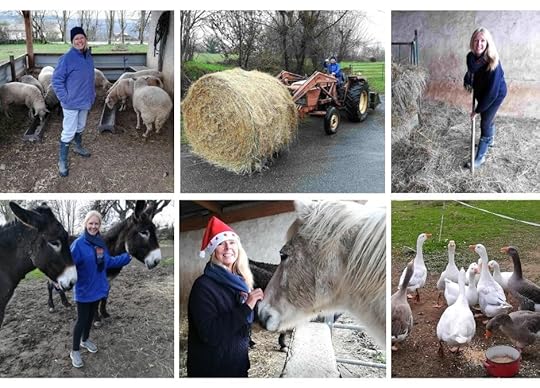 A housesit with a horse, two donkeys, a herd of sheep, a sheepdog, lots of poultry, and several cats!HOUSESITTING IN EUROPE
A housesit with a horse, two donkeys, a herd of sheep, a sheepdog, lots of poultry, and several cats!HOUSESITTING IN EUROPEIt was much easier for us (as UK passport holders) to housesit in Europe before BREXIT.
When we first started housesitting in France, we could simply stay as long as we liked.
But this time, in order to stay longer than 90 days out of any 180 (the Schengen rules) we needed to apply for a longer stay visa.
This entailed gathering and photocopying a lot of paperwork to meet the requirements for the application followed by a personal interview at a TLS Visa Centre. There are three such centres in the UK.
Once we’d attended our personal interview we had to wait 10-14 days.
It was an anxious time for us as there was no way of knowing then if we’d even get our visa applications accepted.
Thankfully, after ten days we got our passports back, and inside them was our new French Long Stay Visa. Hurray!
HOW TO GET A HOUSESITTING ASSIGNMENTWe started out by joining a housesitting website. There are two I’d recommend to you. The first is HouseSitMatch and the other is TrustedHouseSitters.
You join as a homeowner looking for a housesitter or as a housesitter looking for a housesitting assignment.
Once you have joined you can set up your personal profile page.
In your profile as a potential housesitter, I would suggest you start by introducing yourself, then say something about why you want to housesit and any experience you might have already.
If you haven’t done a housesit before then ask people who know you to do a character reference attesting to your trustworthiness and good character.
If you are looking to care for animals, then say what experience you have with specific types of pets, and how much you enjoy the company of animals.
For example, in the past, I’ve owned a horse and dogs and poultry and so have a working knowledge of how to care for them and I loved doing so. Include suitable photos of you in your profile.
Apply for housesits on the site that interest you. You can filter your search by country and date if you prefer.

 HOUSESITTING WEBSITES
HOUSESITTING WEBSITESThe links I have provided to the housesitting websites HouseSitMatch and TrustedHousesitters are affiliate links which means that if you click through my link and decide to join as a member of either of these sites then I may receive a small commission at no extra charge to you. It helps to support this site and I thank you for that.
I can give you a 12% discount code off TrustedHousesitters using this code: 12TRUST
Note: you can browse the sites for free so why not go ahead and take a look?
GOOD HOUSESITTING ETTIQUETTEHousesitting can be a great experience, but it’s important to be responsible and respectful while taking care of someone else’s home.
There are also lots of housesitting forums on Facebook where you can chat with other housesitters and find out more about the life of a housesitter and to garner some savvy housesitting tips.
Communication is key from the outset. Make sure you have a clear understanding of the homeowners expectations and any specific instructions for the house, pets, plants, or other responsibilities.
During the housesit, it is a good idea to keep the homeowners updated on the status of the house, especially if anything unexpected happens. I like to send regular WhatsApp or Messenger to reassure them all is well. Often its just a cute pet photo.
GOOD HOUSESITTING TIPS
Emergency Contacts: Obtain emergency contact information, including the homeowners’ contact details, neighbours, and local plumber, electrician, etc. Know the location of fire extinguishers, first aid kits, and emergency exits. Familiarize yourself with the nearest hospital and emergency services.
House Tour: Before the homeowners leave take a tour of the house with them. Make note of important details like where the circuit breaker is, how to operate security systems, and any specific care instructions.
Security Measures: Follow any security protocols provided by the homeowners. Ensure that all doors and windows are locked and the alarm system (if any) is functioning. Ask if the homeowner uses cameras inside or outside the house.
Pet Care: If you’re taking care of pets, follow the feeding schedule, give them attention, and take note of any peculiar behaviour. Keep their living areas clean. Make a note of the local vet contact number in case of emergency.
Daily Routine: Stick to the homeowners’ daily routine as much as possible. This includes feeding pets, watering plants, garden maintenance, and any other tasks specified by the homeowners.
Mail and Packages: Collect the mail and any packages regularly. If the homeowners expect deliveries, coordinate with them or follow their instructions. On a long housesit we were asked to send mail onto our homeowner’s alternative address on a weekly basis.
Before You Leave: Clean Up: Leave the house in the same or better condition than you found it. Clean up after yourself and ensure everything is in order.
Replace Consumables: If you’ve used any household items like toiletries, food, condiments, or cleaning supplies, replace them before the homeowners return.
Return of Keys: Make sure to return any keys or access cards as agreed upon with the homeowners.
Feedback: Provide feedback on your experience, and let the homeowners know about any issues or concerns that arose during your stay. Consider writing a review on the homeowner’s housesitting profile page, if applicable.
Thank You Note: Leave a thank-you note expressing your gratitude for the opportunity to housesit. I like to leave fresh supplies in the fridge including a meal that can be reheated. Maybe even a bottle of wine.
By following these tips, you’ll help ensure a positive housesitting experience for both you and the homeowners.
I hope you’ve enjoyed this post explaining about housesitting. It really has been a fabulous experience for us as housesitters and a valuable part of our travels.
We have been so very fortunate, in that our very first homeowners became such great friends.
Sadly, Monsieur Smudge, the chat in the chateau, has now passed away.
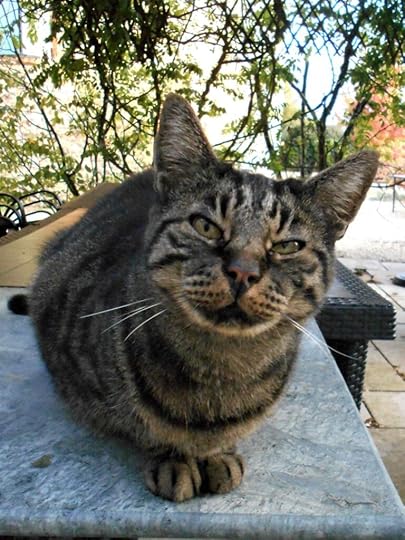 Monsieur Smudge – the chat in the chateau.
Monsieur Smudge – the chat in the chateau.But from starting out on our housesitting journey, and from our very first assignment, being able to live like a local by housesitting continues to enrich our lives.
It has be a particular joy to have been able to return time and time again to this now familiar to us beau maison in southwest France.
So, in the meantime, as we say in France: A la prochaine fois!
Have you done any housesitting?
Are you keen to try housesitting?
Would you like to housesit at home or abroad?
Let me know. I’d love to hear from you!
I RECOMMEND TRAVEL INSURANCE – WHY NOT GET A NO-OBLIGATION QUOTE TODAY?

The post Housesitting – Live Like a Local! appeared first on The Backpacking Housewife.
December 22, 2023
Penang: A Food Fest With Friends!
During a recent trip to Penang, the food capital of Malaysia, the backpacking husband and I planned a delicious Penang Food Fest!
We were fortunate to meet up with some very dear friends on the island who showed us around some of the very best places to eat. Our friend Bob lives on Penang and other dear friends, Sally and Gordon and Sarah, had driven over to the island from Kuala Lumpur to meet with us.
We all spent a fabulous and fun few days together exploring Penang’s ancient UNESCO Heritage Site of Georgetown, with its famous street art and fabulously authentic street food, for which there’s always an orderly lunchtime line.
We’d also worked up an appetite by taking a field trip to discover Penang’s rainforests and nature trails.
Read more about thing to do in Penang in my post My 10 Best Things To Do In Penang.
Then once back in Georgetown, we wandered around wonderful areas like Little India, finding fabulous GEM Restaurant for a hot curry and then lots of yummy and fragrant Indian street food stalls.
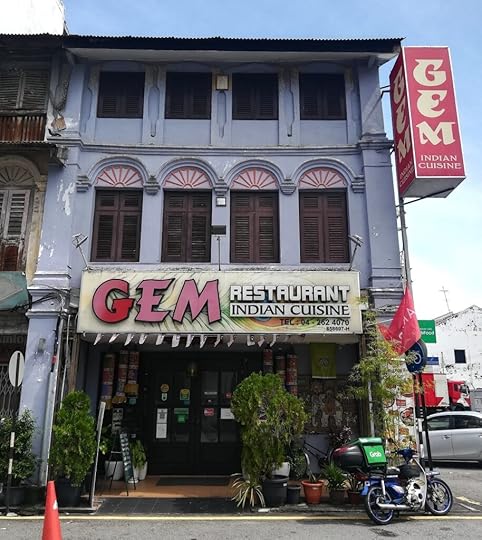
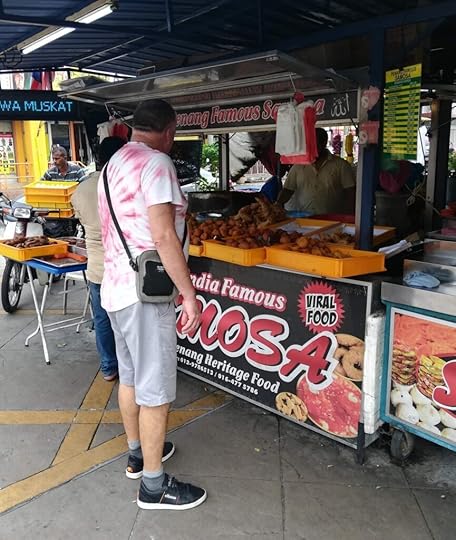
Another foodie discovery (and a place once frequented by my travel foodie hero the Late Great Anthony Bourdain) was The Jetty Food Court – just across the road from Clan Jetties of Penang – for local dishes like Char Koey Teow and Wan Tan Mee.
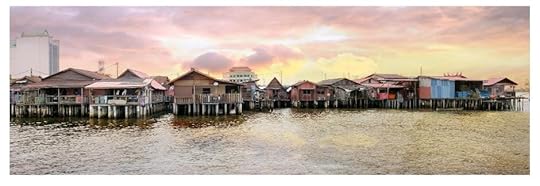 The Clan Jetties of Penang
The Clan Jetties of Penang The Jetty Food Court Penang
The Jetty Food Court PenangWe also really enjoyed the Penang café culture. It was so nice to stop and have a refreshing cool drink or a spot of brunch. One of my favourite brunching spots is the ‘Coffee Cave’ at Toh Soon Cafe on Bishop Street, Penang.
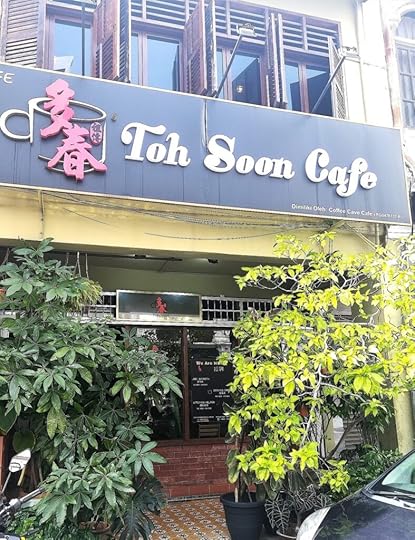
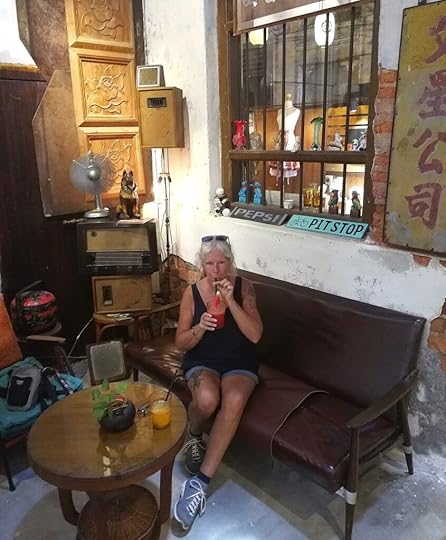
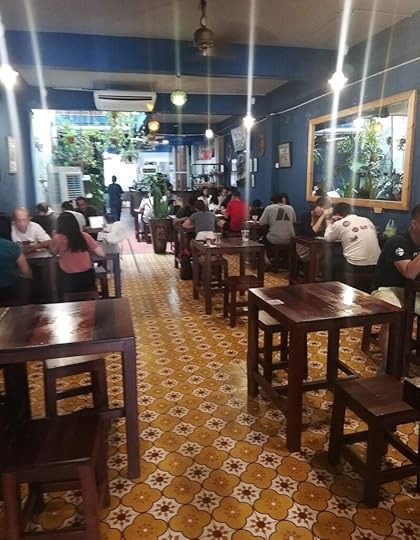 PENANG FOOD FEST!
PENANG FOOD FEST!And then, for our last day on the island, we’d planned a delicious Penang food fest.
Again, we’re not talking fancy expensive restaurants, but traditional cafés and gourmet food courts and hawker stalls.
Amazing quality food and so affordable!
SPECIAL TIMES WITH SPECIAL FRIENDS IN PENANGWe’d all had a wonderful and authentically Asian dinner together the previous evening at Foong Wei Heong restaurant.
Our friend Bob had recommended this restaurant – which is wonderful for gatherings – and he’d ordered an array of delicious and diverse local dishes for us to try.
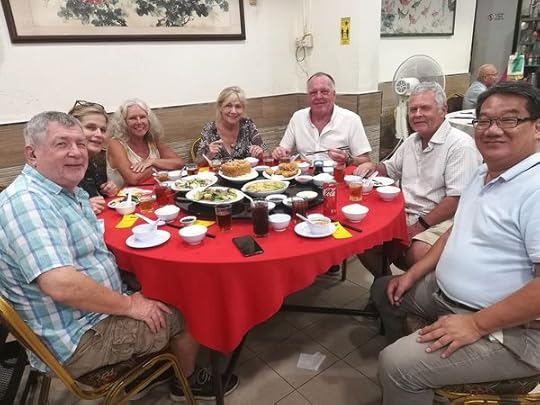

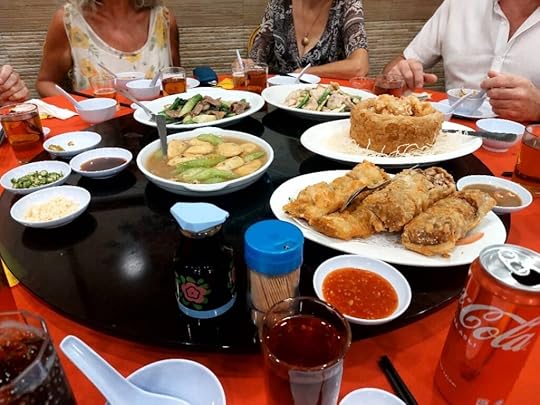 DESSERT AT CHINA HOUSE ON BEACH STREET PENANG
DESSERT AT CHINA HOUSE ON BEACH STREET PENANGAfter dinner, we all piled over to our dessert destination on Beach Street, to the stunningly beautiful heritage building of China House. Bob says you haven’t been to Penang unless you’ve been to China House!
And, thank you to Gordon, for buying us all a huge slice of cake each!
 Eating cake at China House Penang
Eating cake at China House Penang DIM SUM FOR BREAKFAST
DIM SUM FOR BREAKFASTThe next morning, we met up with Sally and Sarah for breakfast (early or you don’t get a table!) at the popular Fu Er Dai Dim Sum restaurant where they sell hundreds of dim sum baskets every day. We ordered an assortment of dim sum that filled our table with dozens of fabulous steam baskets of delicious treats.
 Dim Sum for breakfast!
Dim Sum for breakfast!Then we ate a late lunch of cake (again) at China House. (3rd visit for us!)
In the evening, we met up with our lovely friends for a farewell dinner at Sungai Pinang Food Court Paradise and we all enjoyed a fabulous BBQ seafood feast. What a very special time shared with such special friends!
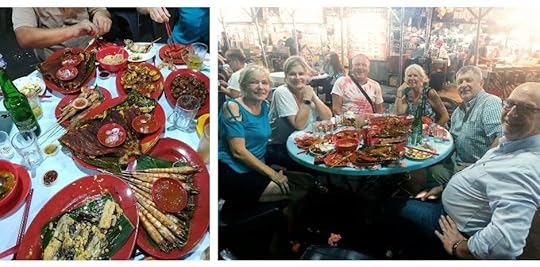
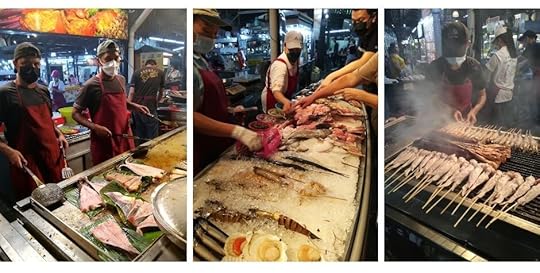
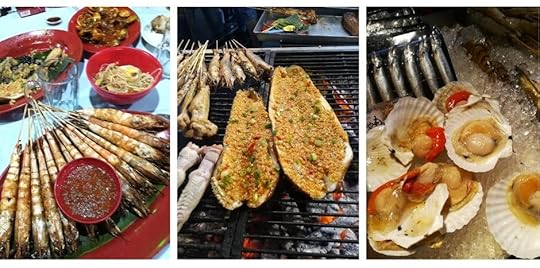 PENANG FOOD FEST!
PENANG FOOD FEST!You can see from my photos that it was all truly amazing.
Do check out my post on My 10 Best Things To Do In Penang.
And the post I wrote (with map) on Penang’s Famous Street Art.
Au revoir dear friends and Penang – I feel sure we’ll be back!
RIP: In loving memory of our dearly departed and much missed lovely friend, Sarah.
On Penang we stayed at The Prestige Hotel and we booked using Booking Dotcom


The post Penang: A Food Fest With Friends! appeared first on The Backpacking Housewife.
Christmas Past: Ten Years On
December 2023: I want to wish everyone a Happy Christmas and a blessed New Year when it arrives.
I also want to thank you for your friendship and support over this past year.
Many of you are dear old friends and we have a wonderful history together. Some of you are lovely new friends – maybe we met this year on our travels – and I’m delighted you’re all here on my ‘nicest people’ list! For me, this Christmas is especially poignant because it’s a ten-year anniversary.
It’s exactly ten years since the backpacking husband and I spent a Christmas together with all our three boys in Scotland. Ten years since we decided to sell everything we owned and travel the world.
But I think back on that wonderful Christmas of 2013 and it makes me smile.
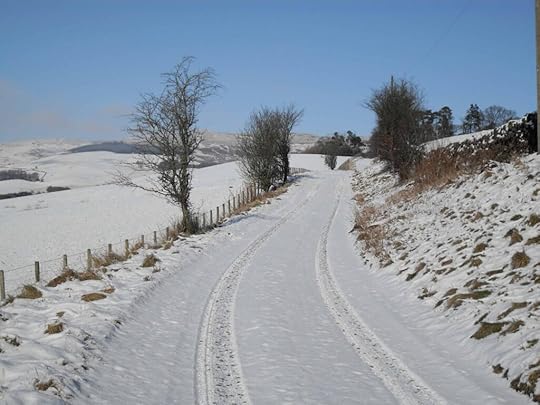 Snowy lane to our cottage in ScotlandCHRISTMAS PAST: TEN YEARS ON
Snowy lane to our cottage in ScotlandCHRISTMAS PAST: TEN YEARS ONHappy holiday images flood through my mind: a handmade Christmas wreath on the cottage door. Snow softly falling outside. Bing Crosby crooning ‘White Christmas’ across a kitchen filled with the smell of home cooking and homely warmth emanating from the old Aga cooker.
I remember Christmas cards from family and friends on the shelves and tinsel on the ceiling beams.
An evergreen swag, made from the foliage I’d brought in from the pine forest opposite our cottage, draped over the stone fireplace. A kitchen table laden with fruits and homemade treats.


Photos: Taken 10 years ago for a ‘Prima’ Christmas magazine shoot
And, in the sitting room, a log fire burning. In the corner, a real pine Christmas tree fragrant and sparkling with lights, decked with decades of our families’ tree decorations and surrounded by carefully chosen gifts in various shapes and sizes all wrapped up in tartan gift wrap.
We loved that lovely old cottage deep in the Scottish countryside of Dumfries and Galloway.
We bought the cottage back in 1990 as a derelict shepherd’s bothy from the country estate of the Dukes of Buccleuch, who lived in the nearby castle.
Do read about My Top 10 Scottish Castles in Dumfries and Galloway.
We’d renovated and extended over the years, turning a tiny and remote and once derelict damp and neglected old place, into a cosy country home.
 Winter views from our cottage in Scotland
Winter views from our cottage in ScotlandGrowing up, it was the only home our boys had ever known and where they’d spent their formative years, attending the local village school, playing in the surrounding forests and hills and glens.
At Christmas, back then, they were alternatively the Three Shepherds’ or the Three Kings in the village Christmas Nativity play!
You can read about our previous life in Scotland in my post ‘A Secret Place in Scotland’.

At Christmas, our boys were either the Three Shepherds’ or the Three Kings’ in the village Christmas Nativity play!
CHRISTMAS PAST: TEN YEARS ONBack in December 2013, husband and I had been empty nesters for a while and that’s when our plan to sell up and travel the world as middle-aged nomads had taken form.
Our eldest and middle sons had been living in the city of Edinburgh while at university.
Having graduated, our eldest had decided to stay in Edinburgh to live and work.
Middle son, graduating two years after his brother, had just accepted a teaching position in South Korea.
Youngest had already been working away for three years in Tenerife and Greece.
I don’t suppose our boys were surprised by our idea of travelling the world long term, because while they were growing up, we’d always prioritised family travel and so they were already well-travelled themselves.
It took a year to sell the cottage, so we had spent that year sorting out the loft, downscaling our belongings and preparing to live out of one small backpack each.
We were moving out in the January of 2014.
But until then, late that December, we were all home for a very special Christmas together in Scotland.
All of us knowing we each had new experiences to look forward to in the New Year.
And it was special. It was perfect.
It was a Christmas to cherish forever in our memories and to keep in our hearts for always.
 Back in December 2013, Janice and doggies at home in Scotland
Back in December 2013, Janice and doggies at home in ScotlandI think back to that Christmas ten years ago and my heart swells with gratitude.
Although, I can also hardly believe that ten years has passed so quickly.
But, of course, there are some things in life that time or distance won’t ever change.
We are still proud parents and Mum and Dad. We love our boys dearly and we are still a tight and loving family unit. We also now have wonderful daughters-in-law and three gorgeous grandchildren!
Over the past ten years, the backpacking husband and I have spent many Christmases abroad – sometimes in Europe and often in hot and tropical places like Malaysia, Philippines, and Thailand.
Sadly, we won’t get to spend Christmas with our family this year, as we are all many miles apart.
But we’ll send gifts and we’ll connect over the airwaves and we’ll video chat over the internet.
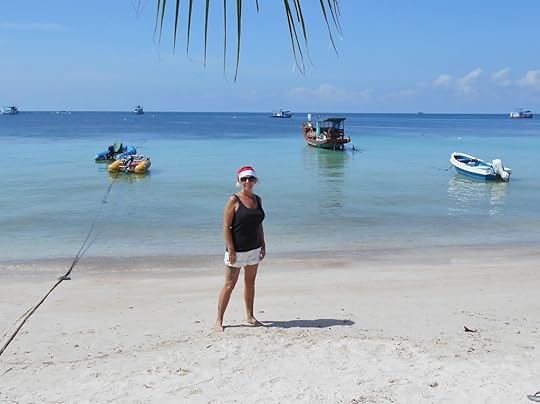
Over the past ten years, the backpacking husband and I have spent many Christmases abroad
And, we’ll all look forward to when we get to see each other again in 2024.
And it will be special. It will be perfect.
Wherever you are in the world and however you celebrate, I wish you a very happy Christmas and a peaceful New Year.
Janice xx

I recommend Travel Insurance – Get a NO OBLIGATION QUOTE TODAY from World Nomads

The post Christmas Past: Ten Years On appeared first on The Backpacking Housewife.
December 11, 2023
Japan Travel: Fukuoka, Hiroshima, Miyajima, Tokyo, Osaka.
Is it your dream to travel to Japan? It has been my dream for many years, especially to visit Japan in springtime for the sakura or cherry blossom season between late March and into May.
Of course, it can be dauntingly expensive to travel to Japan (especially from Europe) and to then explore several Japanese cities in this peak travel season.
But, in late March this year and right at the start of the sakura season, we had an opportunity to travel to Japan on a budget after visiting our son and his family who live in Daegu, South Korea.
We decided, after our family visit was over, that we would take the KTX Train – Korean bullet train – down to Busan in South Korea and fly from Busan’s (Gimhae) Airport over to Fukuoka in Japan.
 A trip to Japan during ‘sakura’ the cherry blossom season has long been on my travel bucket list!TRAVEL TO JAPAN
OUR JAPAN ITINERARY
A trip to Japan during ‘sakura’ the cherry blossom season has long been on my travel bucket list!TRAVEL TO JAPAN
OUR JAPAN ITINERARY
Fukuoka – our gateway to travel to Japan – is only a one-hour flight from Busan.
We planned to spend fourteen days in Japan in four different cities.
Day 1-4 in Fukuoka.
Day 4-7 in Hiroshima – including a day trip to Miyajima.
Day 7-10 in Tokyo.
Day 10-13 in Osaka.
Day 14 Osaka Kansai Airport Hotel.
First, we’d spend four days and three nights exploring Fukuoka before taking the Shinkansen – the Japanese Bullet Train – to Hiroshima. We would also stay three nights in Hiroshima.
We also planned a day trip to Miyajima Island while staying in Hiroshima
In planning our itinerary, it actually worked out less expensive to fly from Hiroshima onto our next city – Tokyo – than to take the train.
Our third city on this trip to Japan was to be Tokyo.
We took the short flight from Hiroshima and booked a hotel in Central Tokyo for another three nights.
Our fourth city was Osaka – this time for 2 nights – because in the planning stages we found our exit flight from Japan to Malaysia was much less expensive flying from Osaka than if we were to fly out from Tokyo.
Which explains why we didn’t finish up our trip in the Japanese Capital.
We are always conscious of our travel budget and were determined to keep a keen eye on the costs of transport and accommodations on this trip.
To show you how it is possible to do a two-week trip to travel to Japan on a budget for two people – I will be sharing our total transport and accomodation costs with you right at the end of this post.
SPOILER ALERT (See end of post for the details):
Total Costs (two weeks/two people) = LESS THAN £1000 or $1245!
Importantly, I do want to tell you about prepaid travel cards for travel to Japan.
TRAVEL CARDS: SUICA AND JR PASSES Click to read my post on Should I Buy A Suica Card?
Click to read my post on Should I Buy A Suica Card?
I wrote a post for you (click the image above) about the discounted tourist travel cards – Suica Cards and Japanese Rail Passes (JR Pass) that you need – and absolutely must read – if you’re planning your trip to Japan. Suica Cards, in particular, help make travel around Japan so much easier.
You load cash on the card and just swipe to board a local train, bus, tram, or ferry, etc.
You can also use the Suica card in some shops and vending machines.
The JR Pass is a tourist-only discount prepaid card for intercity travel. Eg: Shinkansen Bullet Trains.
In my post – Should I Buy A Suica Card – I explain the differences between the Suica Card and the JR Pass and how you can order them BEFORE you arrive and how to collect them in Japan.
TABLE OF CONTENTS
OUR JAPAN ITINERARYTRAVEL CARDS: SUICA AND JR PASSESFUKUOKAHIROSHIMAMIYAJIMATOKYOOSAKATHE COST OF OUR TWO WEEKS IN JAPANTOTAL COSTS FOR TWO PEOPLE IN UK£ (approx) US$ FUKUOKA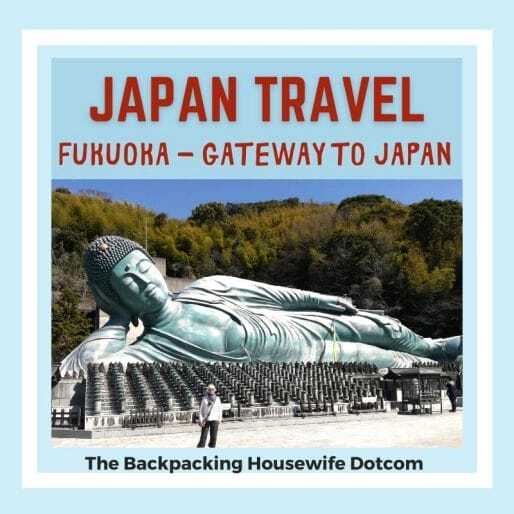 Click to see my post on Fukuoka – Gateway to Japan
Click to see my post on Fukuoka – Gateway to Japan
We absolutely loved Fukuoka and we plan to go back there for a longer stay next time because we enjoyed the city so much. In a recent survey, Fukuoka is consistently rated as the best city in Japan for a good lifestyle.
In Fukuoka, our itinerary included culture in seeing the World’s Largest reclining Buddha at the Nanzoin Temple and wandering around the beautiful Japanese garden in bloom with cherry blossoms at Nanzoin.
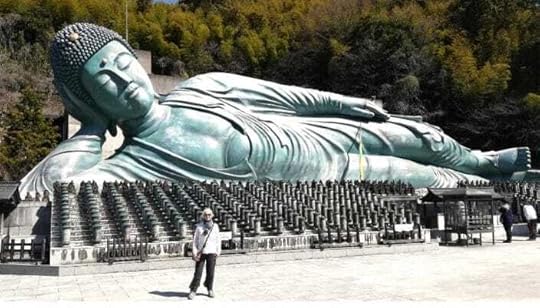
Fukuoka is a food city and so eating Hakata Ramen at the original and famous ramen restaurant was a must.
We also wanted to see the famously extravagant musical fountains at the Canal City Mall in Fukuoka and to try a highball (whisky) in a Highball Bar.
Hakata is famous for its yatai or street-food ‘tents’ that specialise in fresh local dishes – often seafood – and which pop up each evening along the streets flanking the canal.
Eating at a Yatai is popular with both locals and tourists and we had a fabulous experience eating in a Yatai and met some very interesting and fun new friends.
You can read more about this – and see a video I made – in my post on our adventures in Fukuoka!
Where we stayed in Fukuoka:
From Fukuoka Airport (FUK) we took the airport express train to the main Hakata Station. Then we took a metro train to Nakasu Kawabata Station.
We stayed at Hotel Hakata Nakasu Inn booked using (affiliate link) Booking Dotcom
Our hotel was in the central Hakata district of Nakasu in Fukuoka and a short walk away from everything we wanted to see and do in Hakata and from the nearest metro train station (1350 feet away).
Read my entire post on our trip to Fukuoka: Fukuoka – Gateway To Japan.
HIROSHIMA

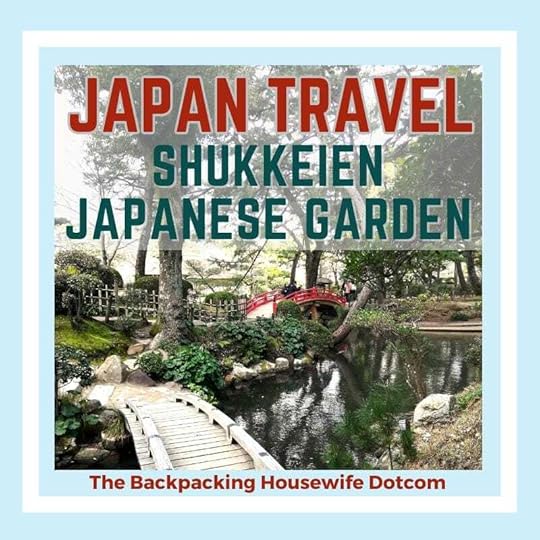
Hiroshima was everything and more than I ever expected from the dark tourism aspect of the Hiroshima Memorial Peace Park and the Atomic Dome to The Peace Museum - an emotional experience – and one I immediately spoke about on video.

Also in Hiroshima, we visited ancient Hiroshima Castle with its Samurai Exhibit and enjoyed the cherry blossoms and beautiful Shukkeien Japanese Gardens.
Please do read all my posts with photos and videos of our time in Hiroshima.
Where we stayed in Hiroshima:
After arriving in Hiroshima on the Shinkansen Bullet Train from Fukuoka, we made our way to central Hiroshima using the metro/subway to XX Station.
We stayed at J-Hoppers Guest House in a very comfortable private double room just a 10-minute walk from the Peace Park.
Our room at J-Hoppers was clean and comfortable and in traditional Japanese style that I would highly recommend you try.
I made a video about it in case you are wary of considering staying in a hostel.
It simply suited our budget and allowed for a more expensive hotel in Tokyo.

MIYAJIMA

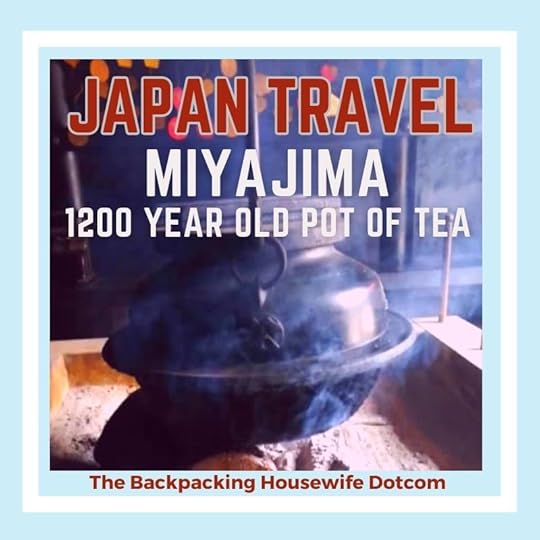

We also travelled to and explored Miyajima Island – an easy day trip from Hiroshima by tram to the port and then a short ferry over to the island – where the first thing you see from your viewpoint on the Island Sea is the famous Miyajima Torii Gate.
Miyajima is a fantastic place. It was a real adventure and an absolute highlight of our entire trip.
We were able to enjoy Miyajima’s fabulous food and also take the ‘ropeway’ of cable cars up to Mount Misen.
Then we hiked to the most exciting thing ever – The Shrine of the Eternal Flame – at the top of the mountain.
Inside the Shrine of the Eternal Flame, where the fire has been burning continually for the past 1200 years (the flame that was used as the source to light the Peace Flame in Hiroshima Memorial peace Park) there is a big pot of tea brewing that you can take drink that is said to have healing properties.
I really wanted to try that 1200-year-old cup of tea!
Do read more about and see my photos and videos of this fabulous day!
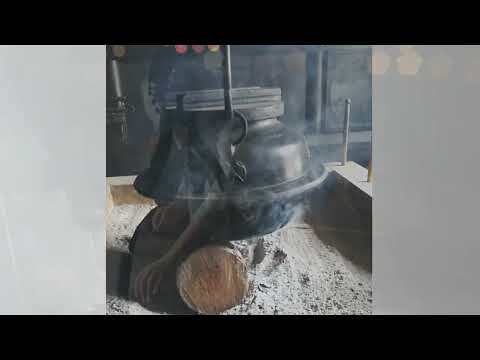
TOKYO


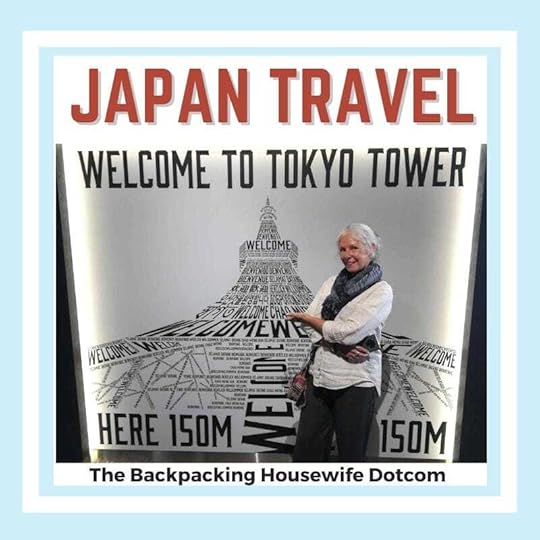
Wow – what can I say about the world’s largest city? Sensory overload!
I absolutely loved our three days in Tokyo. Of course, it certainly wasn’t long enough to even scratch the surface of things to do and see and experience in Tokyo but we packed a lot in.
We travelled easily around the city swiping our Suica Cards and using the street trams and the subway system.
I’d love you to read my post, see my photos and my videos, of the fantastic time we had in my Highlights of Tokyo post.
We went to the top of the Tokyo Tower.

We ate sushi and steak and walked around all of the most popular and quirky city centre districts of Tokyo.
We went to the Senso-Ji Temple – the oldest shrine in the city and the most visited in Japan.
We walked (several times just for the fun of it) across the world’s busiest pedestrian crossing known as ‘Scramble Crossing’ and we wandered with the masses around Ueno Park – Tokyo’s largest park – to truly admire the cherry blossoms of Tokyo!
In Tokyo we stayed in a great location at Hotel Monterey Akasaka in Minato City Akasaka.
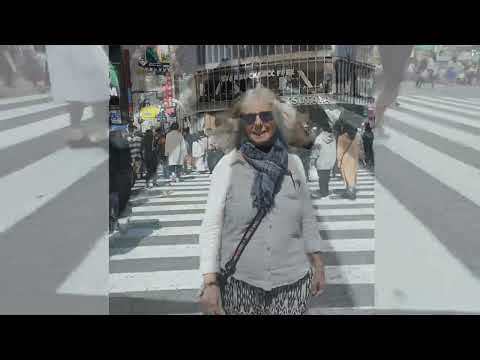
OSAKA
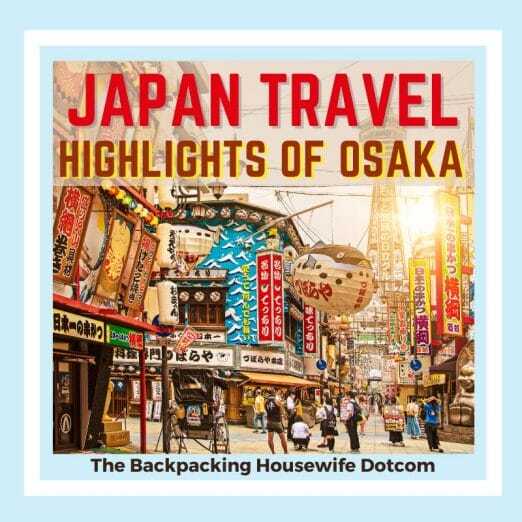
We flew on a budget flight from Tokyo to the City of Osaka and then we took the airport train into the city centre district of Namba.
It was wonderful wandering along the canal walkways and across the bridges to see Osaka in the daytime, but even more exciting when we returned after dark, to see Dotonbori Street sparkling in all its neon-light glory!
Dotonbori is the famous tourist area and the subject of many action movies with its huge animated crustaceans and billboards and advertising posters.

Osaka is known as a Japanese foodie city and we enjoyed trying the local specialties and dining at many of the smaller and more curious ‘hole in the wall’ style eateries.
Our hotel was – importantly – just a ten-minute walk away from Dotonbori Street.
We stayed at The Holiday Inn Osaka Namba just a few minutes’ walk from Namba Station and the Sinsaibashi shopping area.
We booked all our accommodation in Japan with (affiliate link) Booking.com
We stayed in Osaka for two nights before heading over to Osaka Airport for a night in order to meet with an early flight.
It’s worth bearing in mind that although transport links are good – Kansai International Airport (KIX) – is about 45km (over 20 miles) from the city centre.
We stayed at the convenient (affiliate link) Kansai Airport Washington Hotel.
But if you want to do more than we did in Osaka – like spend a day at Japan’s Universal Studios or visit a Grand Shrine and Osaka Castle then you might like to spend a few days more in this wonderful city.
I do hope you’ll explore all my posts from our Japan adventure.
This trip to Japan really was incredible in so many ways.
I had high expectations to start with but I was still bowled over by it all.
I’m already dreaming of our return to explore more of Japan.
What a truly amazing country and fantastic travel destination!
THE COST OF OUR TWO WEEKS IN JAPANI promised you a breakdown of our transport and accommodation costs for our 14 day / 12-night trip to Japan.
Please note: I don’t include any food and drink costs as you have to eat and drink wherever you are and everyone’s budget and preferences are different.
We mostly eat a breakfast included in our hotel rate. Street food for lunch and sometimes that’s a yummy Lawson’s sandwich. Then a mid-priced restaurant for dinner. Occasionally we do splash out and go out for something special.
Neither have I included the cost of entry to any tourist attractions.
Again, it’s a personal choice and current prices can always be sourced using the internet. I do include information and links on buying tickets in my posts.
Do note we travel light. Hand luggage only. No checked bags on flights.
Hotels: We pre-booked our accommodations in Japan with Booking.com
Trains: We use 12Go, Train apps, and Google maps for timetables and tickets.
Flights: We look up flights on Skyscanner. Book flights directly with the airline.
Below are TOTAL COSTS for TWO PEOPLE in UK£ (& approx) US$:Day 1: Fly one-way from South Korea to Fukuoka Japan: £60 or $75
On arrival we collect 2 Suica local transport cards. Total value: £50 or $63
Day 1-4: We stayed at Hotel Hakata Nakasu Inn – Fukuoka – 3 nights: £113 or $142
Shinkansen Bullet Train (using 12GO as not payable on SUICA) Fukuoka to Hiroshima: £87 or $110
Day 4-7: We stayed at J-Hoppers Guest House in Hiroshima – 3 nights: £90 or $115
We took the tram and ferry over to Miyajima Island using our prepaid Suica Cards.
Day 7-10: We flew from Hiroshima to Tokyo: £60 or $75
We stayed Hotel Monterey Akasaka in Tokyo – 3 nights: £240 or $308
Day 10-13: We flew from Tokyo to Osaka: £80 or $100
We stayed at The Holiday Inn Osaka Namba Hotel in Osaka – 2-nights: Free on IHG Loyalty Points
Day 14: One night at Kansai Airport Washington Hotel at Osaka Airport: £70 or $100
Departure: We flew on one-way tickets with Air Asia from Osaka to Penang Malaysia: £140 or $180 (an amazing price btw).
Total cost of all transport and accommodation for two people for two weeks in Japan exploring Fukuoka, Hiroshima, Miyajima, Tokyo and Osaka: £990 or $1,245
Less than £1000!!
Have you found these costing helpful?
Have you found my posts on Japan informative?
Are you planning a trip to Japan?
What cities do you plan to visit?
Let me know. I’d love to hear from you!

The post Japan Travel: Fukuoka, Hiroshima, Miyajima, Tokyo, Osaka. appeared first on The Backpacking Housewife.
December 5, 2023
Japan: Highlights of Osaka
Visiting Dotonbori street Osaka was a surreal and amazing adventure!
Osaka was the last city in our two-week four-city tour of Japan after exploring Fukuoka, and Hiroshima, and Tokyo.
I absolutely loved Dotonbori Street, the principal tourist area of Osaka, and the star of many movies.
And why not – when the street is animated by giant robotic crustaceans!

Apparently, it was all started by the the Kani-Doraku crab restaurant, when they created their giant animatronic crab billboard, which proved so popular with tourists that all the other restaurants followed suit!
Now everyone wants their photo taken with the weird and wonderful animated creatures and superhero characters.
None more famous all over Japan than the giant illuminated Glico ‘running’ Man (est 1935) and now an icon of Osaka.
 Dotonbori street
Dotonbori street Dotonbori Street Osaka runs along the Dotonbori river canal from Dotonboribashi Bridge to Nipponbashi Bridge and is filled with fabulous boutiques and shops.
Once again, as in Tokyo, seeing the fabulous Japanese-bohemian style clothing on offer, I had serious fashion envy and felt so frustrated with my 7kg carry-on only size backpack. Whhhaaaaa – I did sooooo want that lace skirt!

HIGHLIGHTS OF OSAKA
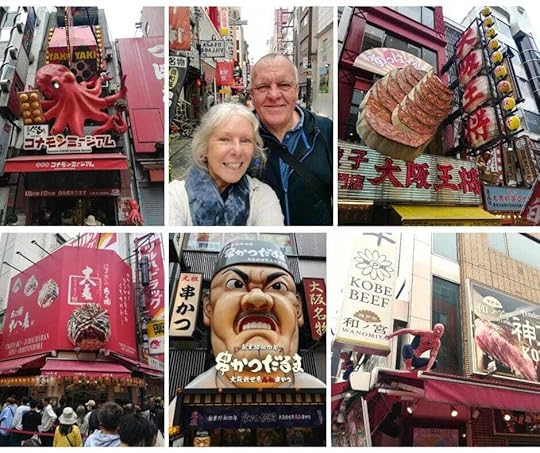 OSAKA – COLOURFUL SPARKLING NEON-LIT STREETS
OSAKA – COLOURFUL SPARKLING NEON-LIT STREETSIt was wonderful wandering along the canals and bridges and seeing the sights of Osaka in the daytime but even more exciting when we returned after dark.
The area of Dotonbori Street was sparkling in all its neon-light glory!
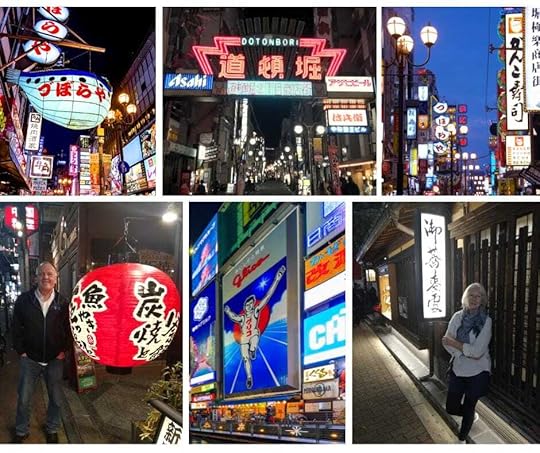 DOTONBORI STREET FOOD
DOTONBORI STREET FOODWe’d stopped of at a few street food stalls for lunch – Osaka is said to be Japan’s street food capital – but now we were looking for a restaurant for dinner. We were spoilt for choice!
 DOTONBORI STREET OSAKA RESTAURANTS
DOTONBORI STREET OSAKA RESTAURANTSWe even found a fabulous Japanese curry house through an old door and down some steps into a unconventional looking basement with graffiti covering the walls – which we added to – while we waited for our Katsu Curry!
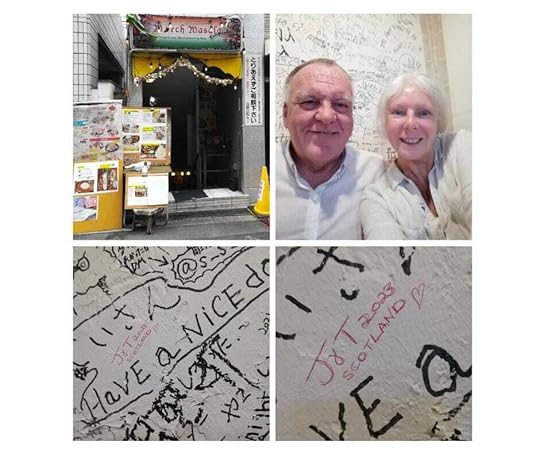 We added to the graffiti on the walls while we waited for our Katsu curry!
We added to the graffiti on the walls while we waited for our Katsu curry!Osaka is also a city of modern high-rises and affluent-looking neighbourhoods.
For example, our hotel was on a street lined with Ferrari, Lamborghini, and Rolls Royce showrooms.
We stayed at (affiliate link) The Holiday Inn Osaka Namba – just a few minutes walk from Dotonbori Street and the centre of all the interesting sites and restaurants.
We booked all our accommodation in Japan with (affiliate link) Booking.com
Two nights in Osaka gave us a great flavour of this energetic city.
We really enjoyed everything about Osaka’s central tourist district.
But, to be honest, after two non-stop weeks of excitement and sightseeing and travelling from Fukuoka, to Hiroshima, and onto Tokyo, we were feeling quite exhausted. I know – it’s an age thing!
But if you want to do more than we did in Osaka – like spend a day at Universal Studios, visit a Grand Shrine and Osaka Castle, and also perhaps the Aquarium – then you may like to spend a few days longer in this wonderful city.
 Osaka City Decorative Street Grid
Osaka City Decorative Street GridOur third and last night was spent at Osaka airport and a hotel to meet with an early morning flight. It’s worth bearing in mind that although transport links are really good – Kansai International Airport (KIX) – is about 45km (over 20 miles) away from the city centre.
We stayed at the convenient (affiliate link) Kansai Airport Washington Hotel.
Do click on the Japan Image Box below to see all my other posts on our fabulous Japanese adventure.
Featuring The World’s Largest Buddha Statue at Fukuoka to Hiroshima and a 1200 year-old cup of tea at Miyajima Island and onto Tokyo and finally here in Osaka.

I’m already dreaming of my return to explore more of Japan. What a truly amazing country and fantastic travel destination!
Are you planning a trip to Japan?
What cities do you plan to visit?
Have you found my posts interesting and informative?
Let me know. I’d love to hear from you!
The post Japan: Highlights of Osaka appeared first on The Backpacking Housewife.
December 3, 2023
Japan: Highlights of Tokyo
Highlights of Tokyo: I was SO excited for our two-week four-city trip to Japan this year and for our first time in Tokyo during the springtime blossom season!
After exploring Fukuoka and then taking the Shinkansen or ‘Bullet Train’ to Hiroshima and prior to us finishing our trip out of Osaka – we were heading to Japan’s capital city for the highlights of TOKYO!
three days and THREE Nights in TokyoI had high hopes and great expectations for our visit to the largest and quite possibly the most crazy city in the whole world.
But, with just three days and three nights in Tokyo, I knew we had to keep our itinerary real and prioritise what we wanted to see and do in the few days we had there. So this was our wish list and itinerary an our own highlights of Tokyo.
OUR TOKYO WISH LIST AND ITINERARY OUR TOKYO WISH LIST AND ITINERARY1.Tokyo Tower – Minato District 2. Scramble Crossing – Shibuya District3. Hachiko Dog Statue – Shibuya Station3. Senso-Ji Temple – Asakusa District4. Ueno Park – Ueno District5. The Tokyo Food SceneExploring Iconic City Centre DistrictsWHERE IS THE BEST AREA TO STAY IN TOKYOTHE BEST TIME TO VISIT TOKYOGETTING AROUND: I’ve included a note on where each of these attractions are located using the Tokyo subway. I recommend you get a Suica Card to make travel around Tokyo using buses, trams and subway trains, easier and more convenient – but as these are discounted tourist travel cards – you should arrange them before travel to Japan. I’ve written a post for you about how to get Suica Cards and JR Passes and the difference between them.
HIGHLIGHTS OF TOKYO 1.Tokyo Tower – Minato District The Backpacking Housewife at Tokyo Tower!
The Backpacking Housewife at Tokyo Tower!I wanted to SEE the whole of Tokyo and the only sure way to do that on one day is from a tall vantage point.
I absolutely love an iconic city tower. And, in the past, I’ve enjoyed our experiences viewing the city of Kuala Lumpur from the top of the Petronas Towers, Taipei from the 101 Tower, and Ho Chi Minh City from the Bitexco Tower.
So, I was really looking forward to gazing over the cityscape of the world’s largest city, from the highest possible floor of the Tokyo Tower. Read a whole post and see my photos and videos on my experience At The Tokyo Tower.
The Tokyo Tower looks exactly like the Eiffel Tower because it was actually inspired by the French version. But, of course, the Tokyo Tower is taller!
I was also hoping for a view of a snow-capped Mount Fuji in the distance for a highlight of Tokyo.
Because, it’s said that on a clear day, there are great views of the mountain from the observation deck. You can find out more about our Tokyo Tower experience and if we did get to see Mount Fuji in my Tokyo Tower post.
Getting there by Subway: Toei Subway, Oedo Line – Akabanebashi Station; Tokyo Metro, Hibiya Line – Kamiyacho Station.

2. Scramble Crossing – Shibuya District
This world-famous pedestrian crossing is a must see and do experience in Tokyo in the trendy downtown district of Shibuya.
The Shibuya intersection has a reputation as the world’s busiest road crossing. It’s estimated 1,000 to 2,500 people cross every two minutes giving rise to its famous nickname “scramble” as pedestrians cross from all directions at once.
 Shibuya Intersection – the world’s busiest road crossing
Shibuya Intersection – the world’s busiest road crossingThe crossing is often seen as an iconic image all around the world of ultra-modern Tokyo as the junction is surrounded by huge video screens and advertising hoardings. I couldn’t wait to experience it for myself.
I actually walked across the crossing several time just for the fun of it.
Getting there y subway: The crossing is just outside the Shibuya Station.
Do watch the video I made while I was there – as I was so excited to be walking amongst the Tokyo crowd and experiencing the phenomenon of the world famous and iconic Scramble Crossing!

3. Hachiko Dog Statue – Shibuya Station
The statue of Japan’s most famous dog, Hachiko, is located outside Shibuya Station, so you can stop to see it on your way to or from the Scramble Crossing.
Hachiko was a real dog who lived in Tokyo in the early 1900s. He was known for meeting with his owner at that spot outside the train station every single day.
Then, after his owner passed away, he continued to wait.
Poor Hachiko waited at that spot outside the station for ten years and he became famous for his loyalty and devotion.
Hachiko (November 10, 1923 – March 8, 1935) was a Japanese Akita dog and – perhaps a little bizarrely – you can see a taxidermied Hachiko with his original fur on display at the National Museum of Nature and Science.
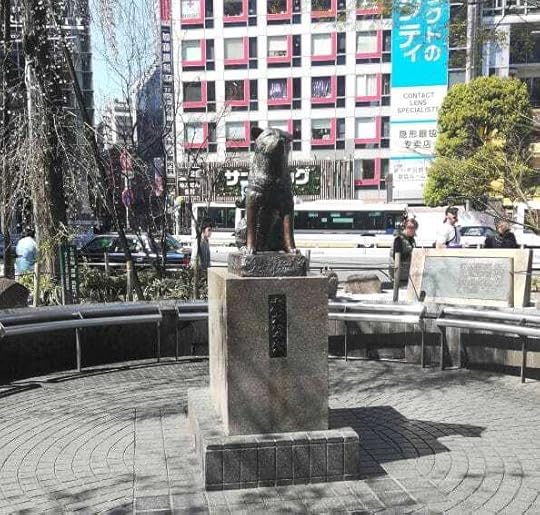 Japan’s most famous dog – Hachiko – is located outside Shibuya Station
3. Senso-Ji Temple – Asakusa District
Japan’s most famous dog – Hachiko – is located outside Shibuya Station
3. Senso-Ji Temple – Asakusa District
Sensō-ji is Tokyo’s largest and, dating from 645, the city’s most ancient temple.
Both the temple and its Kaminari-mon (the thunder and lightning Gate) are important symbols of the city. This beautiful Buddhist shrine is dedicated to the Bodhisattva Kannon, the Goddess of Mercy.
The Senso-Ji is also the most visited temple in the whole of Japan.
Located in the historic Asakusa District, this neighbourhood offers a more traditional feel of Tokyo. As you walk along the boulevard (Nakamise Dori) seeing people dressed up on traditional Japanese clothing – renting a kimono is popular – it will almost feel as if you time travelled back in time
Getting there by subway: Ginza Line – Asakusa Station.
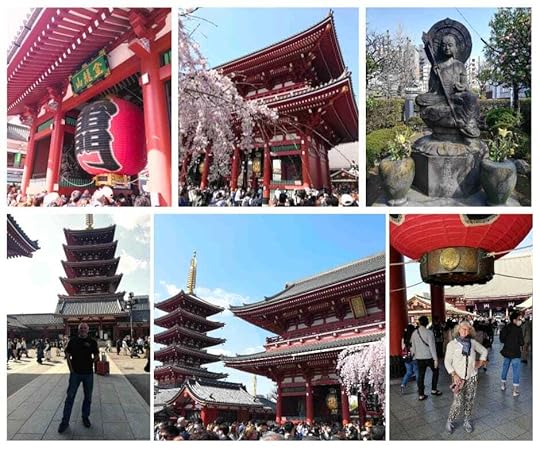 At Senso-Ji – Tokyo’s Largest Buddhist Temple
4. Ueno Park – Ueno District
At Senso-Ji – Tokyo’s Largest Buddhist Temple
4. Ueno Park – Ueno District
As we were visiting Japan in the ‘sakura’ or cherry blossom season, we were looking to immerse ourselves in the popular activity of walking amongst and admiring the beautiful blossoming trees.
Ueno Park is located in the Ueno ‘Green District.’ It’s Tokyo’s largest park.
It has several attractions including a zoo, many museums, shrines and temples.
And… 1200 blossoming cherry trees!
The day we visited the park was very busy indeed.
The paved promenade between the rows of blossoming cherry trees was packed with people taking photos and selfies amongst the pale pink blooms.
Every inch of the grassy areas under the trees were occupied by families having their picnics together. It was really quite surreal and rather wonderful.
Getting there by subway: Ueno Station is a stop on the JR Yamanote Line. The park is just across the street from Ueno Station.
 In Tokyo Ueno Park in Cherry Blossom Season5. The Tokyo Food Scene
In Tokyo Ueno Park in Cherry Blossom Season5. The Tokyo Food SceneYou cannot fully embrace Tokyo without experiencing its food! We went sightseeing by day – stopping off in quirky café’s and having lunch in strange looking sushi bars – and found a fabulous Japanese curry house through an old door and down some steps into a bohemian style basement.
At sundown, with colourful neon-lights twinkling across the city, we sought out popular dining spots offering amazing Japanese cuisine.
I had to write a whole post about The Tokyo Food Scene, as it was such a highlight of our trip, and I also made this video!

Exploring Iconic City Centre Districts
It was never going to be possible for us to see and do everything that Tokyo has to offer in the time we had to spend in the city – the world’s largest city!
So we finished off by taking the subway – The Yamanote Line – to specific districts just to walk around them and see them for ourselves and to experience the sights there.
 On a crowded Tokyo subway train
On a crowded Tokyo subway trainThere are actually twenty-three districts or ‘wards’ in the Tokyo Metropolitan Area. The iconic ones are perhaps:
Super-trendy Shibuya with its scramble crossing. Traditional Asakusa with its amazing street food stalls. Neon-lit and upscale Shinjuku. Expensive and elegant Ginza. And energetic Akihabara – also known as ‘Electric Town’.
It was exhilarating to ride on the busy Tokyo subway trains and to walk around these iconic districts.
We walked for miles. I absolutely loved the fashion scene in Tokyo. With travelling light (we did this six-month trip around Asia with only kg of hand luggage – I had clothes envy!
Tokyo is so vibrant. It’s also quite crazy and wonderfully eccentric in places like Akihabara!
It’s not at all unusual to see young people dressed up as their favourite fictional anime and manga character as they peruse the various electronics shops, comic shops, and maid cafes, located here in Akihabara – Electric Town.
Getting there By Subway: Tokyo Metro Hibiya Line – Akihabara Station
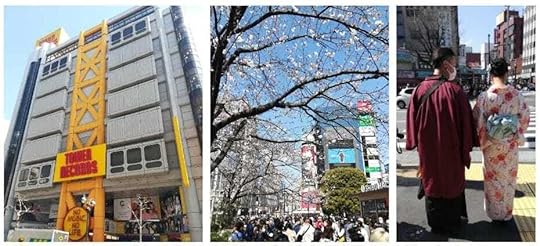
 Akihabara – Electric Town!
WHERE IS THE BEST AREA TO STAY IN TOKYO
Akihabara – Electric Town!
WHERE IS THE BEST AREA TO STAY IN TOKYO
There are so many great places to stay in Tokyo that it is difficult to know where to stay when visiting Tokyo.
We stayed at a hotel called HOTEL MONTEREY AKASAKA (affiliate link) which I can recommend as it was wonderful and in a great location for sightseeing. Our three nights in a double room cost a total of 238 GBP or approx $300 USD.
Our choice of hotel is in the central Akasaka district and just 1500 feet from the subway station giving easy access to Central Tokyo. We booked all our hotels in Japan using (affiliate link) Booking Dotcom.
THE BEST TIME TO VISIT TOKYOThe best time to visit Tokyo, Japan, depends on the type of experience you’re seeking regarding weather, festivals, and the type of activities you want to do.
Keep in mind that popular times, like cherry blossom season, can be crowded, so plan accordingly. Also, Tokyo is a vibrant city with events and attractions year-round, so you can find something interesting no matter when you visit.
Spring (March to May)
Cherry Blossom Season: Spring is one of the most popular times to visit Tokyo due to the cherry blossoms (sakura). This usually occurs in late March to early April, and the city becomes incredibly scenic with pink and white flowers.
Mild temperatures make it comfortable for outdoor activities.
We took our own trip to Japan and first time in Tokyo in late March. It was perfect. The temperatures not too hot and the weather dry and sunny.
And of course, we got to experience the ‘sakura’ cherry blossoms
Summer (June to August)
Summer in Tokyo can be hot and humid with temperatures often exceeding 30°C (86°F). This is also the rainy season so be prepared for occasional heavy rain. If you can handle the heat you might enjoy summer festivals and events.
Autumn (September to November)
The fall foliage season is another beautiful time to visit Tokyo. Parks and gardens transform into a riot of red and orange colours. Temperatures are milder compared to summer.
Winter (December to February)
Winter in Tokyo is generally mild, with temperatures rarely dropping below freezing. However, it can be cold, especially in January. If you enjoy festive decorations and illuminations, visiting Tokyo during the holiday season can be charming.
Are you planning a trip to Japan?
Is Tokyo on your Itinerary?
Let me know? Leave a comment.
I’d be delighted to hear from you!

The post Japan: Highlights of Tokyo appeared first on The Backpacking Housewife.
November 28, 2023
Japan: Tokyo Food Scene
I absolutely loved the crazy busy madness of Tokyo and I was particularly excited to experience the Tokyo food scene.
Is Tokyo really the food capital of the whole world?
Many a Tokyo foodie will insist that Tokyo is indeed in the top spot because its restaurants have more Michelin stars than both Paris and New York combined.
Is Japanese food really the healthiest food in the entire world?
Japanese chefs will tell you that the emphasis on high protein, the freshest ingredients and healthiest preparation methods, make Japanese cuisine the healthiest food in the world.
During my two-week four-city tour of Japan this year, I made it my mission not only to complete an amazing sightseeing itinerary but to enjoy lots of fresh and authentic and healthy Japanese food.
In Fukuoka, Japan, we had the very best and original Hakata Ramen.
In Hiroshima, we had delicious and tender Teppanyaki.
In Miyajima, we tried every kind of oyster dish including the famous oyster Okomoni-Yaki. See my Miyajima Food Guide!
In Tokyo, I wanted to try everything from the freshest sushi to Wagyu steak!
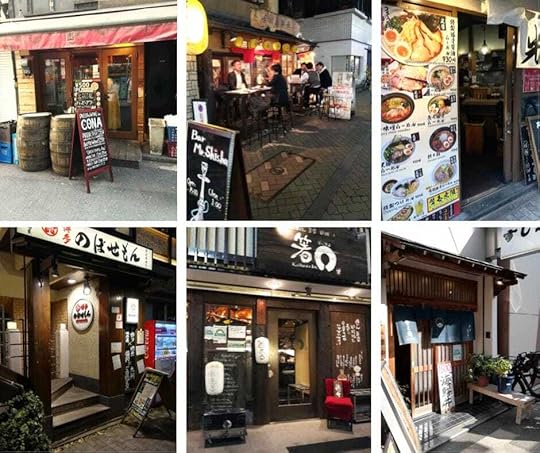 We purposely sought out small independent ‘hole in the wall’ style restaurants bustling with localsTokyo Food Scene
We purposely sought out small independent ‘hole in the wall’ style restaurants bustling with localsTokyo Food SceneYou’ll see from my photos and videos in this post that we did just that as we toured all the exciting districts of Tokyo.
Firstly, we tried several types of sushi at a budget chain restaurant where the sushi is delivered to your table by conveyor belt.
But, for contrast, we also ate at a small independent sushi restaurant, where we sat at a narrow counter and had the sushi expertly prepared right in front of us by skilled sushi chefs with very sharp knives.
Each piece of sushi was then presented to us individually and by hand.
Each piece of sushi was delicate and bursting with flavour!

Sushi!
We purposely sought out small independent ‘hole in the wall’ style restaurants bustling with locals and found an amazingly tasty Japanese curry that way. We also ate (twice) at a fabulous mid-priced Tokyo steak restaurant called Ikinari where the steak ordered (by type and weight) is first brought to your table uncooked for your personal inspection and approval.
Then is it taken away to be cooked to your specific requirements and returned on a sizzling iron platter.
I’m not normally a big meal eater but I was open to trying all types of authentic Japanese cuisine and it was so very delicious!
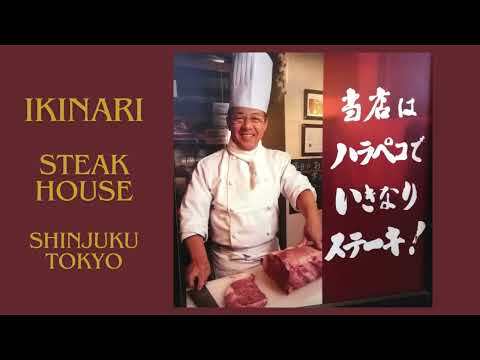
We also ate (twice) at a fabulous mid-priced Tokyo steak restaurant called Ikinari.
And of course, we ate egg sandwiches at Lawson’s convenience stores, again!
LAWSON’S CONVIENIENCE STORE
Lawsons: If you know you know!
And, in our airport hotel, the night before we flew to Osaka – the last city in our two-week four-city tour of Japan – we also had a cheap but ever-so-tasty microwave dinner from a Lawson’s store.
I made the video below to show you that it really is possible to travel – and eat well – in Japan on a budget because we really did a lot – and we ate a lot! – by mixing it up between high price – mid range – and budget experiences.
And, again, I can’t enthuse enough or agree more heartily with the Late Great Anthony Bourdain in his travel show No Reservations about the quality of food from this highly regarded Japanese convenience store.
Lawsons: If you know you know!

A cheap but ever-so-tasty microwave dinner from a Lawson’s store!HOW TO CHOOSE RESTAURANTS IN TOKYO
Choosing restaurants in Tokyo can be a delightful experience and so here are my top Tokyo tips to help you make the best choices:
Research Online: Check online platforms or travel blogs for reviews and recommendations. Use food-focused apps or Google Maps to find popular restaurants and read customer reviews.
Local Recommendations: Ask locals or your hotel staff for recommendations. They often know hidden gems that might not be as well-known to tourists.
Cuisine Preferences: Consider what type of cuisine you want to try. Tokyo offers a wide range of options, from traditional Japanese to international cuisines.
Budget: Determine your budget beforehand. Tokyo has restaurants to fit every budget, from affordable street food stalls to high-end Michelin-starred establishments.
Location: Take into account the location of the restaurant. Tokyo is a vast city, and you might want to choose places that are easily accessible from your accommodation or the areas you plan to visit.
Reservations: For popular or high-demand restaurants, it’s advisable to make reservations in advance. Many top-rated places in Tokyo get fully booked quickly.
Seasonal Specialties: Consider trying seasonal specialties. Japanese cuisine often emphasizes seasonal ingredients so you might get a unique experience depending on the time of year.
Street Food and Food Markets: Don’t forget to explore street food and food markets. Some of the best and most authentic culinary experiences in Tokyo can be found in the bustling street markets.
Adventure and Exploration: Be open to trying new things. Tokyo is known for its innovation in the culinary world, so be adventurous and explore dishes you may not find elsewhere.
Language Barrier: Learn a few basic Japanese phrases or have a translation app handy. While many places in Tokyo cater to tourists, some smaller establishments may have limited English-speaking staff.
Time of Day: Some restaurants may have different menus for lunch and dinner. Check the timings and offerings to plan accordingly.
Food Allergies and Dietary Restrictions: If you have any food allergies or dietary restrictions, make sure to communicate them clearly to the restaurant staff. Some places may be better equipped to accommodate specific needs.
IS DINING IN TOKYO EXPENSIVE?Tokyo is a food lover’s paradise with options for every taste and budget.
Yes, it can be expensive if you want to go high-end, but Tokyoites love to eat out and do so regularly while demanding high quality casual dining.
This makes eating out affordable in Tokyo if you choose your venue and your menu wisely.
 WHERE WE STAYED IN TOKYO
WHERE WE STAYED IN TOKYO
I did a lot of research in choosing where is best to stay in Tokyo as we wanted our accomodation to be affordable, comfortable, but also in an area from where we could travel easily to all the places we planned to visit in and around Tokyo.
Not an easy feat in the world’s largest city!
I use (affiliate link) Booking Dotcom for booking most of our accommodations while travelling.
We stayed at Hotel Monterey Akasaka in the Minato District for three nights.
The hotel is close to the centre of Tokyo and 1500 feet away from the Akasaka-Mitsuke metro tube station.
We found it to be a wonderful hotel in a perfect location for us. Our three night stay total cost – 44,415 Yen (237 GBP).
Are you planning a trip to Japan?
Is Tokyo on your Itinerary?
Will you visit Tokyo Tower?
Let me know? Leave a comment.
I’d be delighted to hear from you!
The post Japan: Tokyo Food Scene appeared first on The Backpacking Housewife.












